Dropshipping remains a lucrative Shopify business model in 2025 – if you choose the right products. With e-commerce evolving rapidly, winning products today often reflect emerging trends (think TikTok gadgets or eco-friendly goods) or evergreen needs like pet supplies and home essentials. In fact, certain markets are booming: the demand for pet products hit a seven-year peak with over $150 billion in sales in 2024, and baby care is projected to soar to $250+ billion globally by 2025. Both beginners and experienced Shopify sellers need to stay on top of these trends to succeed.
In this comprehensive guide, we’ve curated 50+ of the best dropshipping products to sell on Shopify, organized by category (Home, Beauty, Pets, Tech, Wellness, and more). For each product, we’ll cover a brief description, why it’s a great pick (popularity or trend data), ideal target audience, and dropshipping tips – including pricing, sourcing, shipping, and upsell ideas.
Beyond the product list, you’ll find expert sections on how to find winning products in 2025, what types of products tend to sell best, whether to focus on niche products or hot trends, and a comparison of Dropshipping vs Print on Demand. This blog is packed with actionable insights, structured with clear headings and bullets so you can easily scan and find key information. Let’s dive in and discover the top dropshipping product opportunities for your Shopify store in 2025!
Best Dropshipping Products (2025)
Below we break down the top dropshipping products of 2025 by category. Each category includes trending and evergreen items that have strong demand on Shopify. We explain why each product made the list, who the target customers are, and tips to help you profitably dropship it (pricing strategies, supplier/shipping notes, and upsell opportunities). Use this as inspiration for your store’s inventory or as a starting point for further product research.
🏠 Best Dropshipping Products for Home & Kitchen
Home and kitchen products are consistently reliable for dropshippers, with the home interiors market projected to reach $949 billion by 2032. Consumers are eager for items that improve convenience, décor, and lifestyle at home. Trending home gadgets often go viral on social media, making this category a goldmine for both niche and general stores. Here are 10 hot products in the home/kitchen niche:
1.LED Strip Lights
2.Star Galaxy Projector
3.Portable Blender (USB Rechargeable)
4.Vegetable Chopper & Slicer
5.Magnetic Screen Door
6.Smart Video Doorbell (Wi-Fi)
7.Solar Garden Lights
8.Rain Cloud Humidifier (Aroma Diffuser)
9.Blackout Curtains
10.Handheld Milk Frother
1.LED Strip Lights
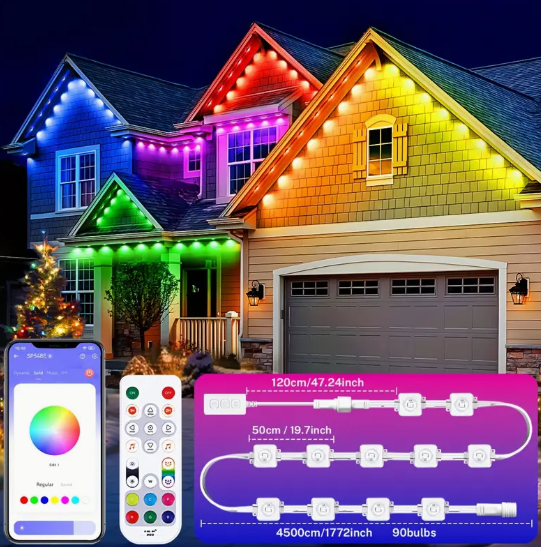
Color-changing LED light strips that can be applied under beds, behind TVs, or along ceilings for ambient lighting. These have surged in popularity thanks to TikTok room makeover videos and the growing DIY décor trend.
Why It’s a Winner: Visually striking and affordable, they cater to teens, gamers, and homeowners who want a customizable ambiance.
Target Audience: Gen Z and millennials (for bedrooms or gaming setups), content creators (for backgrounds), and home decorators.
Dropshipping Tips: Source strips with multicolor and smartphone-app control features; price in the $20–$30 range for a standard 5m strip (allowing ~$10+ margin). Offer fast shipping options, as buyers often want them quickly for projects. As an upsell, include connectors or extra strip extensions, so customers can cover more area without searching elsewhere.
2.Star Galaxy Projector
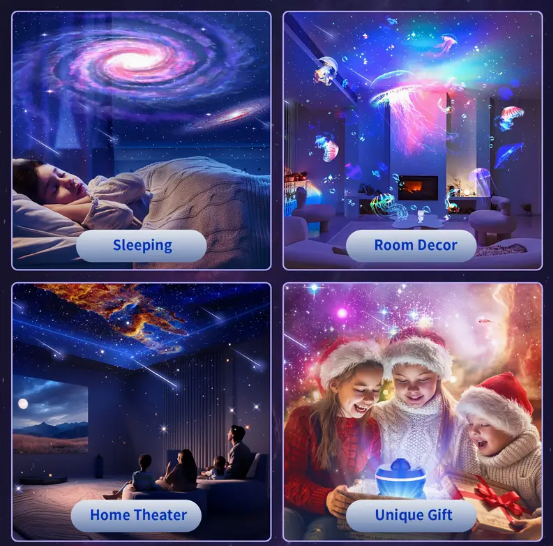
A starry sky or galaxy projector that casts moving stars and nebula clouds on the ceiling. It’s a popular mood-setting gadget, especially in bedrooms or for kids’ rooms.
Why It’s Included: This product went viral under hashtags like #TikTokMadeMeBuyIt, as it delivers a “wow” factor transforming any room into a dreamy space.
Target Audience: Kids (as a night light), teens/young adults (for aesthetic vibes), and even party hosts.
Dropshipping Advice: Emphasize models with multiple lighting modes and Bluetooth speaker functionality for more value. These projectors typically sell for $30–$50; position your price competitively (e.g. $39.99) for a solid margin. Source from reputable suppliers to ensure quality and safety (electronic item standards).
Upsell Ideas: Bundle with an LED strip light or a plush sleep mask (if targeting relaxation) to increase average order value.
3.Portable Blender (USB Rechargeable)

A compact personal blender that charges via USB and lets users make smoothies or shakes on the go.
Why It’s Hot: Influenced by the health and convenience trend, portable blenders (popularized by brands like BlendJet) are in high demand for busy consumers and fitness enthusiasts. They solve an everyday problem – making healthy drinks anywhere – which is key to their appeal.
Target Audience: Gym-goers, travelers, office workers, and students who want quick smoothies or protein shakes.
Dropshipping Tips: Highlight ease of use and safety features (like blending only when assembled correctly). These often wholesale around $10–$15, with typical retail $30–$40. Price yours around $34.99 to stay attractive while leaving room for marketing costs. Ensure the supplier provides multiple color options (shoppers love choosing their style) and decent motor power.
Upsells: Offer a recipe e-book or extra travel cups as a bundle to entice buyers (digital recipe guides have zero shipping cost and add value).
4.Vegetable Chopper & Slicer
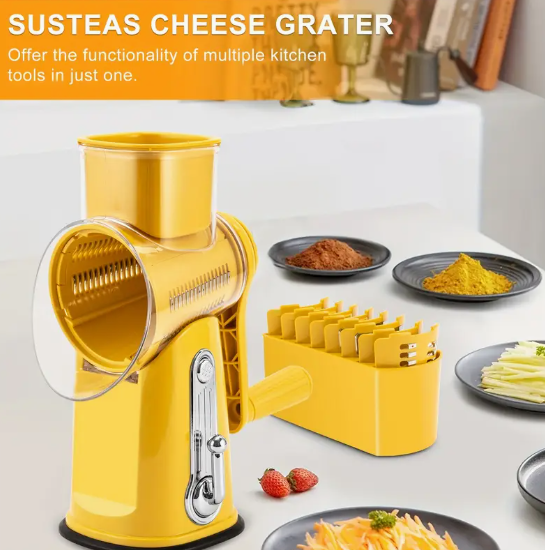
A manual vegetable chopper with interchangeable blades for dicing, slicing, and spiralizing veggies.
Why We Chose It: Kitchen gadgets that save time are evergreen winners. This all-in-one chopper went viral in recipe hack videos, demonstrating how it can prep ingredients in seconds. It consistently ranks among top kitchen dropshipping products.
Target Audience: Home cooks, meal preppers, health-conscious individuals, and parents cooking for families.
Dropshipping Advice: The ideal price range is $20–$30 depending on blade count and quality – affordable enough for impulse buys. Look for suppliers on AliExpress or Alibaba with strong reviews (blade quality matters to customers). For shipping, ensure blades are well-protected to avoid damage or safety issues en route.
Upsell Opportunities: Pair it with a cut-resistant glove (to safely handle blades) or a vegetable spiralizer tool for zucchini noodles, appealing to keto/veggie customers.
5.Magnetic Screen Door

A mesh screen curtain with magnetic closure that lets people walk through hands-free, keeping bugs out while letting air in.
Why It’s Trending: Every spring and summer, this item spikes in demand as households seek easy screen door solutions (especially renters who can’t install permanent screens). It’s frequently advertised on social media and has broad appeal.
Target Audience: Homeowners and renters, particularly in warmer climates or during mosquito season. Also pet owners (whose pets can go in/out through the mesh).
Dropshipping Tips: Emphasize easy installation (usually Velcro or tacks included) and automatic closing feature. Price around $19.99–$29.99; highlight the value compared to fixed screen doors. This item is lightweight – keep shipping cheap or free.
Upsell Idea: Suggest an outdoor bug-repellent LED lamp or doorway draft stopper for winter, showing you understand seasonal needs (and to boost off-season sales).
6.Smart Video Doorbell (Wi-Fi)
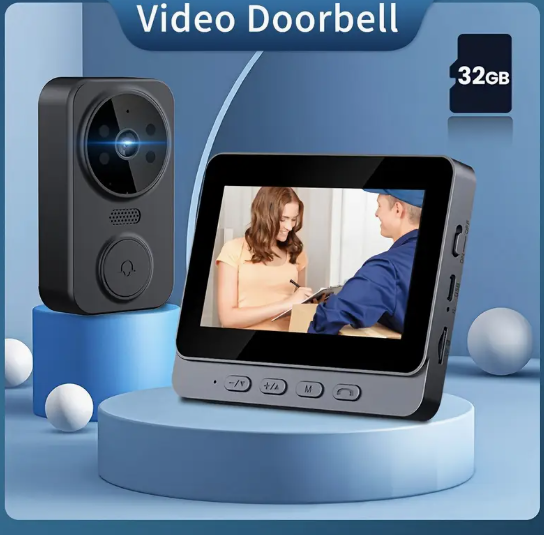
A Wi-Fi video doorbell that lets users see and talk to visitors via a phone app.
Why It’s a Best-Seller: Home security tech continues to grow as a niche. Not everyone wants to pay top dollar for brand-name devices, so affordable dropshipped versions (compatible with apps) are attractive. Search interest in smart home devices remains high.
Target Audience: Homeowners (and even renters) wanting security on a budget; tech-savvy individuals; and Airbnb hosts monitoring entrances.
Dropshipping Advice: Ensure the device is 1080p with night vision and two-way audio to meet consumer expectations. These can retail anywhere from $50–$100; a reasonable price like $59.99 can undercut big brands while yielding profit (assuming supplier cost ~$25). Mention that no monthly subscription is needed (if true), as that’s a selling point versus branded competitors.
Shipping Tip: Work with suppliers that have local warehouse options (U.S./EU) if possible – buyers prefer faster shipping for security gadgets.
Upsells: Offer microSD cards for video storage or a second indoor security camera at a discount to build a full security package.
7.Solar Garden Lights

Solar-powered outdoor lights (often stake lights or string lights) for gardens and pathways.
Reason to Include: Eco-friendly and cost-saving, these lights charge by day and illuminate by night, appealing to homeowners’ aesthetic and practical needs. They often surge in popularity around spring/summer and during holidays for decor.
Target Audience: Homeowners with gardens or yards, DIY landscapers, and even apartment dwellers with balconies (for string versions).
Dropshipping Tips: Highlight easy installation (no wiring) and energy savings. A set of solar pathway lights might retail for ~$29.99 (for 4-8 lights set) depending on quality; source for half that cost or less. Quality matters (waterproof rating), so vet suppliers through reviews. Since they are a bit bulky but lightweight, consider ePacket or local shipping to keep delivery times reasonable.
Upsell Idea: Add complementary garden décor – for example, offer decorative LED string lights or solar-powered motion sensor lights for added security, bundling for a discount to increase cart value.
8.Rain Cloud Humidifier (Aroma Diffuser)
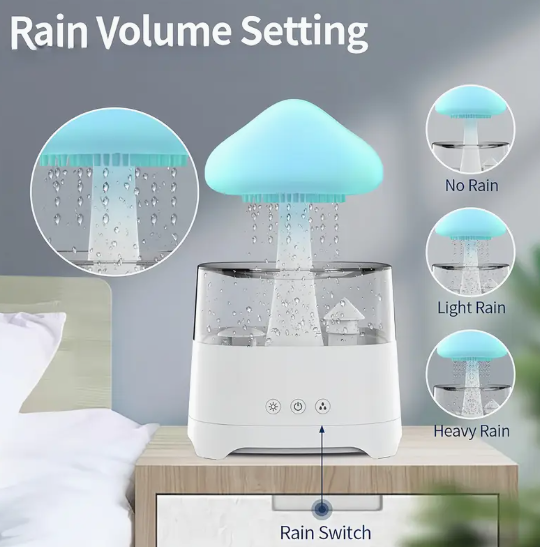
A viral home décor humidifier shaped like a little cloud that “rains” (water drips) into a base, often with LED lights.
Why It’s Popular: This whimsical diffuser took off on social media due to its relaxing visual and multi-function use (humidifier + night light + décor). It taps into the wellness and home aesthetic trends simultaneously.
Target Audience: Office workers (for desk relaxation), those into cute home décor or Kawaii style, parents (for kids’ room humidifier/night light combo), and anyone seeking stress relief at home.
Dropshipping Advice: These typically sell for $30–$40. Make sure your supplier provides all parts (many include USB cable, filters, etc.) and that the item has auto shut-off for safety. In marketing, focus on the soothing aspect and how it improves air humidity for health.
Upsell Opportunities: Include a set of essential oils for aromatherapy use (if the diffuser supports it) or pair with a small USB desk fan for a full comfort package.
9.Blackout Curtains
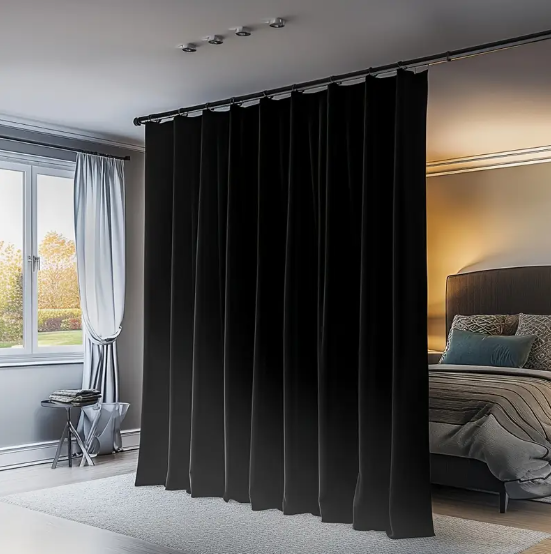
Heavy thermal blackout curtains that block light and insulate windows.
Why They Sell: As people prioritize sleep quality and home theater experiences, blackout curtains remain in steady demand (search interest often peaks mid-year and January). They also appeal to those looking to save on heating/cooling by insulating windows.
Target Audience: Homeowners or renters wanting better sleep (night-shift workers, new parents, etc.), home theater enthusiasts, and anyone in hot or cold climates wanting insulation.
Dropshipping Tips: Curtains are a bit heavier to ship, so work with suppliers offering ePacket or local shipping – possibly source from domestic dropship wholesalers for faster delivery. Offer popular sizes (e.g. 52x84 inches) and neutral colors (gray, navy, black) which fit most rooms. Pricing varies by size and set; for standard sets, around $40–$60.
Upsell Idea: Sell them alongside curtain string lights (for a decorative touch over the curtains) or magnetic curtain tie-backs – cheap accessories that you can bundle for a higher perceived value.
10.Handheld Milk Frother

A battery-powered electric milk frother wand for making foamed milk in coffee, lattes, or matcha.
Why It’s a Great Pick: Coffee lovers are a dedicated market, and this inexpensive gadget lets them recreate café-style drinks at home. It’s frequently recommended in barista and recipe blogs, driving consistent sales.
Target Audience: Coffee and matcha enthusiasts, home baristas, keto diet followers (who make bulletproof coffee), and gift shoppers (it’s a popular small gift).
Dropshipping Advice: This is a low-cost item (often ~$2–$5 from suppliers) that can retail for around $15–$20. That healthy margin makes it attractive for upsells and as a tripwire product. Offer multiple colors or a stand included if possible. Since it’s small, offer free shipping to stay competitive – it won’t cut too deeply into profits due to low weight.
Upsell Opportunities: Bundle with other coffee accessories like a stainless steel milk pitcher or a coffee art stencil set for creating latte art, encouraging true coffee geeks to spend more.
💄 Best Dropshipping Products for Beauty & Personal Care
The beauty and personal care niche is massive and social media-driven – from skincare tools that trend on Instagram to grooming kits addressing everyday needs. Beauty products do well when they solve a problem (clearer skin, better hair) or offer a pampering “treat yourself” factor. In 2025, consumers continue to chase at-home beauty solutions that mimic salon/spa results. Here are 10 of the best beauty items to dropship:
1.Hydrocolloid Acne Pimple Patches
2.Facial Ice Roller
3.IPL Hair Removal Handset
4.Hair Straightener Brush (2-in-1)
5.Heatless Curling Rod Headband
6.DIY Press-On Nail Kits
7.Electric Makeup Brush Cleaner
8.Electric Callus Remover
9.Beard Grooming Kit
10.Silicone Body Scrubber (2-in-1 Loofah)
1.Hydrocolloid Acne Pimple Patches
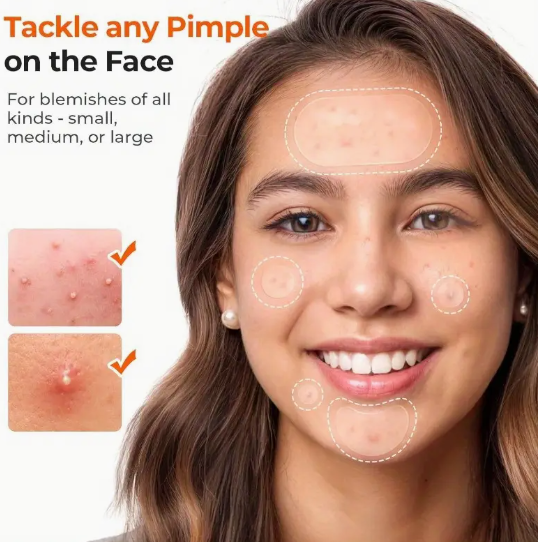
Small acne patches that you stick on pimples overnight to absorb impurities and reduce inflammation.
Why They’re Booming: These went mainstream after countless YouTubers and TikTokers demonstrated patch-covered faces as a skincare hack. They’re affordable, effective, and a repeat-purchase item.
Target Audience: Teens to adults (basically anyone who gets breakouts), especially skincare enthusiasts and those who prefer gentle solutions over harsh creams.
Dropshipping Tips: Quality is key – source patches that are thin and truly effective (often from Korean skincare suppliers). They often come in packs of 20–40; retail pricing around $8–$15 per pack. Consider offering multi-packs for upselling (people often buy in bulk). Lightweight and small, so offer free or very low-cost shipping – they can even be shipped in envelopes.
Upsell Ideas: Pair with other skincare tools like a blackhead remover tool or facial cleansing brush for a complexion care bundle. Also, consider offering cute patch case/storage if available (some brands have them).
2.Facial Ice Roller

A face ice roller (or the trending facial ice bowl concept) used to reduce puffiness, tighten pores, and massage the face.
Why It’s Trending: Cold therapy for skin has trended via the “glass skin” K-beauty movement and countless viral videos showing ice facials. An ice roller is a convenient tool that delivers this benefit without the mess of actual ice cubes.
Target Audience: Skincare enthusiasts, beauty bloggers, and anyone who wakes with puffy skin (e.g. busy professionals, new moms). Also popular among spa-at-home crowd.
Dropshipping Advice: There are plastic ice rollers with gel cores (you freeze the roller) which are cheap (~$3 cost, $15 retail) and stainless steel ones ($10 cost, $25–$30 retail). Both sell well; choose one and price accordingly. Use content marketing – e.g. explain in your product description how it can shrink pores and improve circulation (educating customers builds trust).
Shipping Tip: It’s not very heavy or large, so standard shipping works; just ensure it’s packed to avoid any cracking of the gel head.
Upsell Opportunities: Cross-sell with a jade roller & gua sha set (another facial massage tool) or a mini skincare fridge for storing these tools and products – great for serious skincare aficionados.
3.IPL Hair Removal Handset
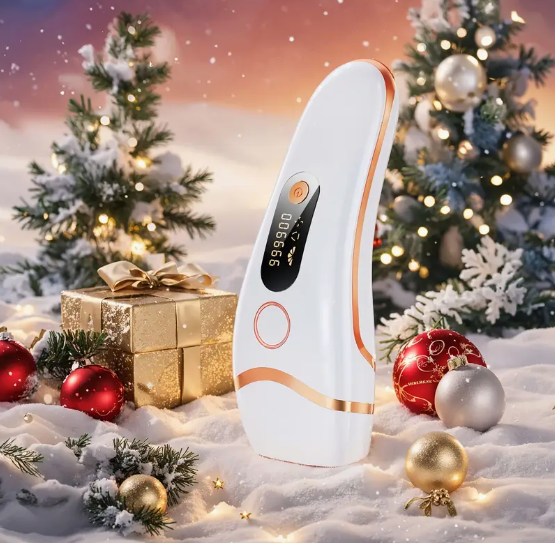
A handheld IPL laser hair remover for long-term hair reduction at home.
Why It’s a Top Pick: These devices have exploded as people look for cost-effective alternatives to salon laser treatments. They promise convenience and privacy – a big draw. Tech improvements have made IPL more affordable, and many dropshipping stores successfully market them as high-ticket items.
Target Audience: Women (and men) seeking hair removal on legs, underarms, bikini line, etc., especially ages 18–40. Great for beauty gadget lovers and those in countries/areas where salon treatments are costly.
Dropshipping Tips: This is a higher price product – typically retailing $80–$150. As a dropshipper, position it as a premium investment (with clear instructions and possibly warranty if the supplier provides). Content is key: include before/after claims carefully (avoid overpromising, but cite any real stats from supplier). Ensure your supplier has certifications (CE, FCC) to indicate device safety.
Pricing Strategy: Aim for ~3x markup; if cost is $30, selling at $89.99 is reasonable.
Upsells: Offer accessories like protective goggles (for IPL use, if not included) or a soothing aloe vera gel for post-treatment skin calming. You can also bundle with a manual razor for pre-shave (since IPL requires shaving beforehand) – a thoughtful addition that shows you understand the user’s journey.
4.Hair Straightener Brush (2-in-1)
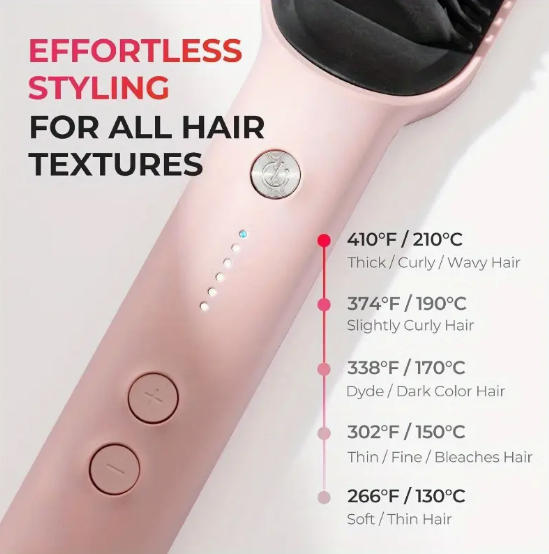
An electric hair straightening brush that combines a flat iron and brush, allowing users to detangle and straighten hair simultaneously.
Why It’s in Demand: Time-saving beauty tools are winners. This gadget simplifies morning routines – a ton of viral videos show curly or frizzy hair transformed quickly with a straightening brush. It appeals to those who struggle with traditional flat irons.
Target Audience: Primarily women with medium to long hair, especially those with wavy/curly hair looking for an easy smoothing solution. Busy professionals and students love it for quick styling.
Dropshipping Advice: Emphasize features like adjustable temperature, anti-scald design, and auto shut-off for safety. These brushes typically sell for $30–$50; find a supplier around $15 or less to maintain margins. Use before-and-after images (from supplier or created content) to showcase results – visuals sell beauty tools.
Shipping: Fairly lightweight but bulky; ensure secure packaging to protect the ceramic bristles.
Upsell Idea: Suggest a heat protectant spray (as a digital info product or as part of a hair care kit customers can add-on) or a travel storage pouch for the brush to increase its portability appeal.
5.Heatless Curling Rod Headband
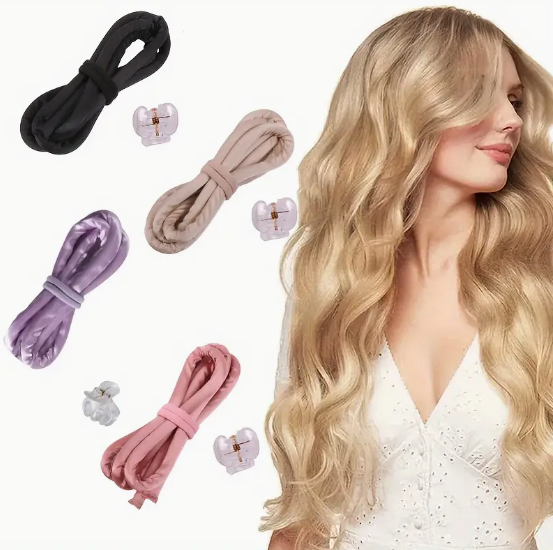
A heat-free curling rod (usually a satin-covered rod or foam) that you wrap hair around to get curls without any heat damage.
Why It Went Viral: TikTok made this product a sensation, with users demonstrating how to wake up with perfect curls using a bathrobe belt or these purpose-made curling ribbons. It taps into the desire for healthy hair (no heat) and is super easy to use.
Target Audience: Women with medium to long hair who want curls without using hot tools – this includes teenagers, moms, and even professional stylists recommending it to clients for low-damage styling.
Dropshipping Tips: This is a low-cost item (often $3–$5 from suppliers) and typically retails $15–$25. It’s a great impulse buy, so use compelling video ads demonstrating the curling process and results. Offer various colors or fabric patterns if available (some come in silk or satin options for deluxe appeal).
Shipping: Very lightweight (essentially just fabric/foam), so you can afford to offer free shipping; vacuum-sealed packaging can reduce bulk.
Upsell Opportunities: Combine it with a satin sleep bonnet or silk pillowcase – products that also focus on protecting hair overnight. This not only increases AOV but positions your store as a specialist in hair care.
6.DIY Press-On Nail Kits
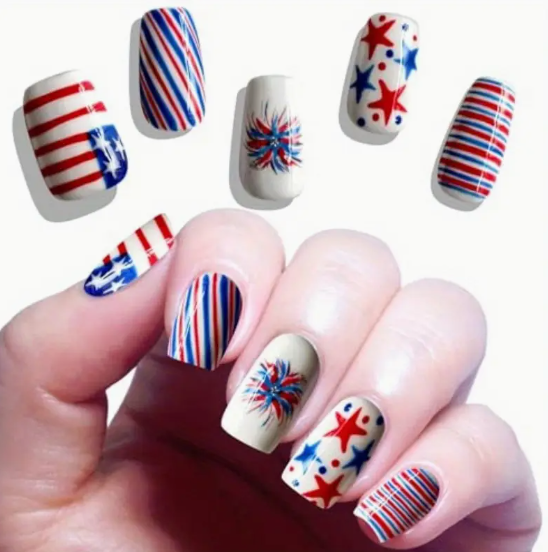
Sets of press-on nails or gel nail kits that allow consumers to get salon-quality nails at home.
Why It’s a Must-Sell: The at-home nail trend grew massively – people realized they can save money and time by applying stylish press-ons or doing their own gel manicures. Social media is full of nail art tutorials using these kits. Press-ons, in particular, are experiencing a renaissance with modern designs that look professional.
Target Audience: Primarily women and teens, especially those who love changing nail designs often or who are budget-conscious. Also great for those who don’t have easy access to nail salons.
Dropshipping Advice: There are a few angles: you can sell press-on nail sets (various designs, glue included) or gel polish kits with UV mini lamp. Press-ons are cheaper and easier to ship. For press-ons, stock trendy shapes (coffin, almond) and designs (marble, glitter, French tips). Price can be $9.99–$19.99 per set depending on quantity and quality (allow for ~$5 cost). Highlight that they’re reusable (if they are) and easy to apply/remove.
Upsell Ideas: Include a nail prep kit (mini file, cuticle stick, glue) if not already, or offer bundle discounts like “Buy 2 sets, get 1 free” to encourage multiple design purchases. For gel kits, upsell extra gel polish colors or nail art stickers to keep them coming back.
7.Electric Makeup Brush Cleaner
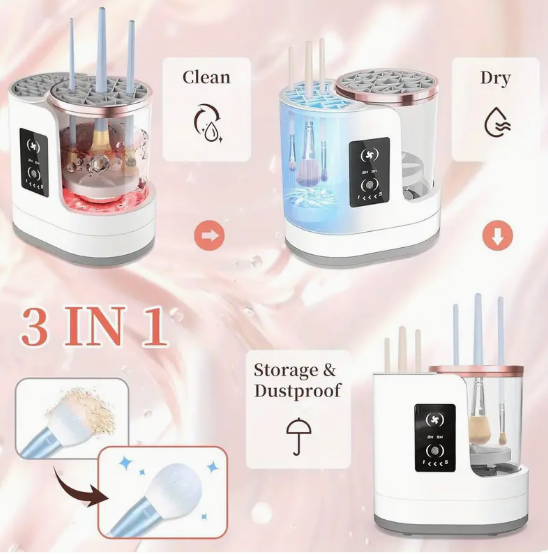
A spinning makeup brush cleaner device that comes with a bowl and spindle to clean and dry brushes in seconds.
Why It’s Loved: Cleaning makeup brushes is a chore many procrastinate. This device turned heads by turning a tedious task into a quick, almost fun process. Beauty gurus have reviewed these on YouTube, boosting their popularity.
Target Audience: Makeup enthusiasts, professional makeup artists (who need to clean brushes often), and everyday users who wear makeup regularly.
Dropshipping Tips: Quality matters – the device should have fittings for various brush sizes and a decent motor. They typically wholesale ~$8–$12 and retail for $25–$40. Aim for the mid-$30s in price, stressing how it extends the life of expensive makeup brushes (a great value argument).
Content Tip: Use a short video or GIF in your product page showing a brush going from dirty to clean in the bowl – very convincing.
Shipping: Ensure the bowl (usually plastic) is well-protected. It’s moderately bulky, so account for shipping costs in your margin.
Upsells: Sell a quick-dry makeup brush towel or a brush holder/organizer alongside it. You could also cross-sell a set of makeup brushes to new makeup users – if they’re buying a cleaner, they might appreciate new tools too.
8.Electric Callus Remover
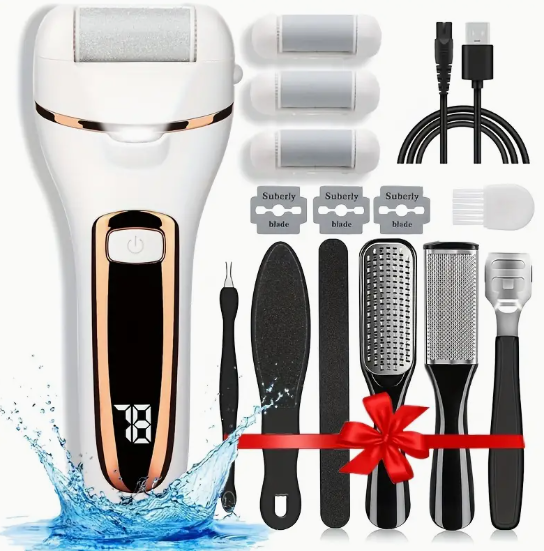
A rechargeable foot callus remover (essentially an electric foot file) for removing dead skin and smoothing heels.
Why It Sells: This is a pedicure problem-solver. Videos of satisfying dead-skin removal may not be glamorous, but they go viral in oddly satisfying content circles. People love personal care gadgets that bring spa treatments home.
Target Audience: Runners and athletes (who often get calluses), people who stand all day (retail, nurses), or anyone looking to keep feet sandal-ready. Appeals to both women and men (foot care is universal).
Dropshipping Advice: Many models exist; look for ones with multiple roller heads and USB recharging for convenience. Supplier cost around $10; typical retail $29.99–$39.99. Write a benefit-driven description (e.g. “Get smooth, crack-free heels in minutes”).
Health Note: Consider including a disclaimer for people with diabetes or sensitive skin to check with a doctor – this builds trust through transparency.
Upsell Opportunities: Great pair with a moisturizing foot mask or repair balm – sell a foot care bundle. Also, a 2-pack of replacement roller heads could be offered to encourage future purchases (or include them as a bonus to clinch the sale).
9.Beard Grooming Kit

A set of beard care tools and products, often including a beard trimmer or scissors, comb/brush, and conditioning oil/balm.
Why It’s in the List: The men’s grooming market is thriving, and beard maintenance is now mainstream. Many men (and their partners gifting them) search for all-in-one kits to keep beards neat and healthy. This product addresses a specific niche with passionate customers – bearded gentlemen!
Target Audience: Men with beards (from stubble to long beards), roughly age 20–50. Also a popular gift (for Father’s Day, holidays, birthdays) from spouses or family.
Dropshipping Tips: Kits can vary; some are simple (comb, oil, balm) while others include electric trimmers. Decide which route – non-electric kits are easier to ship and have fewer returns (no electronics). A decent kit might cost $8–$15 from suppliers and sell for $25–$40 depending on contents. Emphasize natural ingredients in oils/balms if applicable, and the completeness of the kit.
Marketing Angle: Position it as a gift-ready item (many kits come in a nice box) – great for Q4 sales.
Shipping: If including liquids (oil), ensure supplier can ship them safely (no leakage). Non-electric kits are straightforward, but check any customs restrictions on oils if international.
Upsells: Offer a travel pouch if the kit lacks one, or add on a beard apron (those funny grooming catch-cloths that suction to the mirror) for humor and practicality – it’s a low-cost add that complements the kit.
10.Silicone Body Scrubber (2-in-1 Loofah)
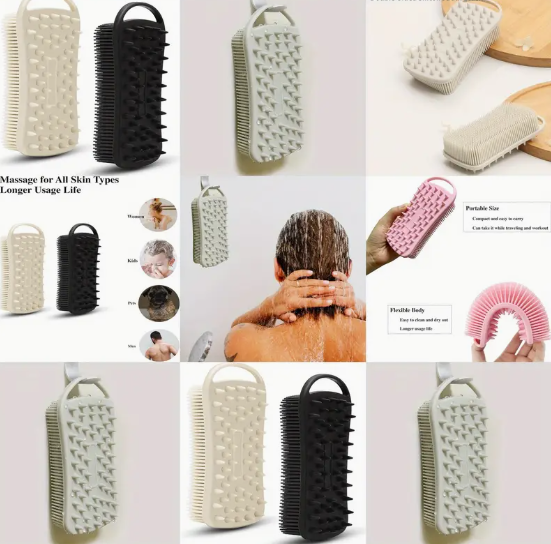
A silicone bath scrubber that often has dual sides (one with soft bristles for cleansing, another with massaging nubs).
Why It’s Gaining Traction: Traditional loofahs harbor bacteria and need frequent replacing; silicone scrubbers are more hygienic and durable. They’ve been trending as part of the self-care and shower routine upgrades (with influencers touting them). Some come in a 2-in-1 form factor combining a sponge and lotion dispenser, which adds novelty.
Target Audience: Pretty broad – anyone who showers! But more specifically hygiene-conscious individuals, skincare lovers (since exfoliation is key to smooth skin), and even gift shoppers (they make great add-on gifts in spa baskets).
Dropshipping Advice: These are cheap to source (maybe $1–$3 each) and can retail for $10–$15. They’re excellent for bundles (e.g., “buy 2 get 1 free” to replace all family loofahs). Highlight benefits like exfoliation, improved circulation, and easy cleaning (quick-dry, no mildew). It’s simple but solve a common issue, which resonates with shoppers looking for small quality-of-life improvements.
Upsell Ideas: Pair with other bath products – e.g., a back scrubber strap or body exfoliating gloves. Alternatively, create a bath bundle with a shower gel or body scrub (if you have a supplier for consumables or perhaps as an affiliate add-on).
🐾 Best Dropshipping Products for Pet Supplies
Pet owners are known to be enthusiastic shoppers when it comes to their furry friends. The pet supply market is huge and often yields repeat customers because pets continuously need food, toys, and care products. Dropshipping pet products can be particularly profitable due to the emotional attachment owners have – they’re willing to spend on keeping pets happy and healthy. Let’s look at 10 of the best dropshipping products for pet lovers:
1.Calming Pet Bed (Donut Bed)
2.Pet Hair Remover Roller
3.Interactive Cat Laser Toy
4.Pet Water Fountain
5.Slow Feeder Dog Bowl
6.Dog Car Seat Cover (Hammock Style)
7.Pet Travel Water Bottle
8.Pet Grooming Glove
9.Cat Backpack Carrier (Bubble Backpack)
10.Snuffle Mat (Nose Work Feeding Mat)
1.Calming Pet Bed (Donut Bed)
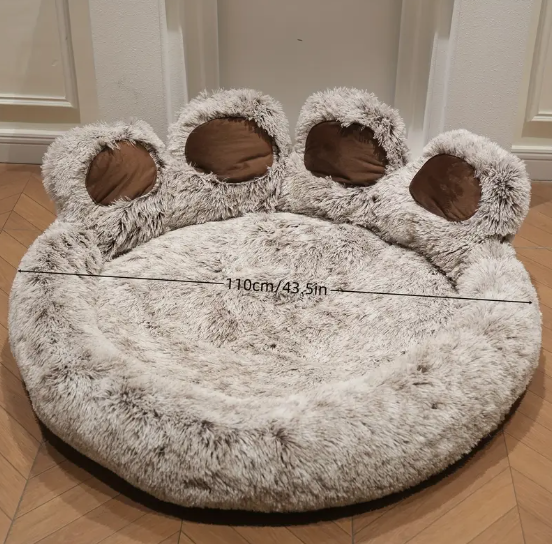
A plush round pet bed with raised rims, designed to be calming by mimicking a mother’s fur (often called a “donut bed”).
Why It’s a Top Pick: This bed went viral a couple of years ago and still remains popular. Pet parents rave about how their cats or dogs curl up and relax in it. Its cozy design appeals to the “pamper your pet” trend.
Target Audience: Dog and cat owners, especially those with anxious pets or those who just want a stylish comfy bed for their pet.
Dropshipping Tips: These come in various sizes (for cats up to large dogs) – offering multiple sizes and colors will broaden your market. They compress for shipping, which helps with logistics, but make sure customers know to let it fluff up. Depending on size, cost might be $8 (cat) to $20 (large dog); retails range $29.99 (small) to $69.99 (XL) typically. Emphasize the anxiety-relief aspect and the washable covers (if applicable).
Upsell Idea: Suggest a pet blanket or toy to go with the bed. For example, “Complete your pet’s comfy corner with a soft fleece blanket – 50% off if added with a bed purchase.”
2.Pet Hair Remover Roller

A reusable pet fur removal roller that picks up hair from couches, clothing, and car seats.
Why It’s Great: Every pet owner with a shedding pet needs this. Unlike sticky tape rollers, these devices (often with a velour surface and a trap compartment) are eco-friendly and effective. They’ve been hot sellers on Amazon and via Facebook ads, solving a daily annoyance for pet owners.
Target Audience: Cat and dog owners – particularly those with heavy shedders (e.g. Labradors, German Shepherds, long-hair cats). Also people who like to keep their home and clothes fur-free.
Dropshipping Advice: This item is relatively inexpensive (around $4–$6 supply) and can retail $19.99–$29.99 due to the value of reusability. Demonstration is key: use GIFs or videos showing fur being picked up in one swipe to drive home its effectiveness.
Shipping: Small and lightweight; easy to offer free shipping. It’s plastic so pack carefully to avoid cracks.
Upsells: Sell it alongside pet grooming gloves (another fur removal tool, but at the source – while petting the animal) or a lint brush for clothes, to cover all bases for pet hair management.
3.Interactive Cat Laser Toy
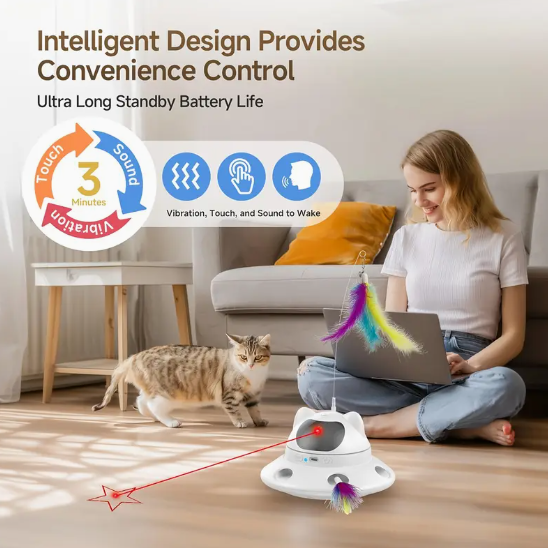
An automatic laser pointer toy for cats, often dome-shaped or tower-shaped that emits a moving laser dot in random patterns.
Why It’s a Winner: Cats are mesmerized by lasers, and an automatic toy means owners can keep their pets entertained without constant effort. This product often goes viral in pet video circles (cute cat content is social media gold).
Target Audience: Cat owners, especially those with indoor cats that need exercise and stimulation. Also good for busy pet owners who can’t play with their cat constantly.
Dropshipping Tips: Look for features like adjustable speed or timer settings (some turn off after 15 minutes to prevent overstimulation). These devices typically retail $25–$40; if you find a supplier around $10–$15, that’s solid. Use product reviews or videos showing cats playing with it – this sells the toy’s value (happy, active cat = happy owner).
Shipping Consideration: It’s electronic – ensure the supplier includes or specifies power source (batteries vs USB charge). If batteries not included, note that clearly.
Upsell Opportunities: Offer bundles with replacement batteries (if it uses AAAs) or pair it with other cat toys like feather wands or catnip plushies to create an “ultimate playtime” kit.
4.Pet Water Fountain

A water dispenser fountain for pets that provides filtered, flowing water.
Why It’s Popular: Flowing water encourages pets to drink more (cats especially prefer moving water). This addresses pet health (hydration) and is a convenience upgrade for owners. Many pet owners consider it a must-have once they see how much their pets love it.
Target Audience: Both cat and dog owners, though cat owners are a primary market (cats can be picky about water). Great for any pet owner who works long hours and wants fresh water circulating.
Dropshipping Advice: There are plastic and stainless steel versions; stainless steel ones are pricier but seen as more hygienic. Basic plastic models wholesale ~$10 and retail $29.99 or so; high-end can go $50+. Decide your target market. Highlight features: replaceable filters (mention how often to change), quiet pump, and capacity (e.g. “holds 2L of water”).
Recurring Revenue Angle: Consider selling filter replacement packs either as upsell or via subscription since filters often need changing monthly. That can create repeat sales.
Shipping Tips: Water fountains aren’t too heavy (mostly empty plastic), but somewhat bulky. Ensure the pump is included and well-protected. Maybe avoid listings where customers have reported broken pumps on arrival.
Upsell Idea: As mentioned, filter packs are ideal (e.g. “Add 3 replacement filters for $9.99”). Also maybe a pet feeding mat (to place under the fountain, catches spills) as a related add-on.
5.Slow Feeder Dog Bowl
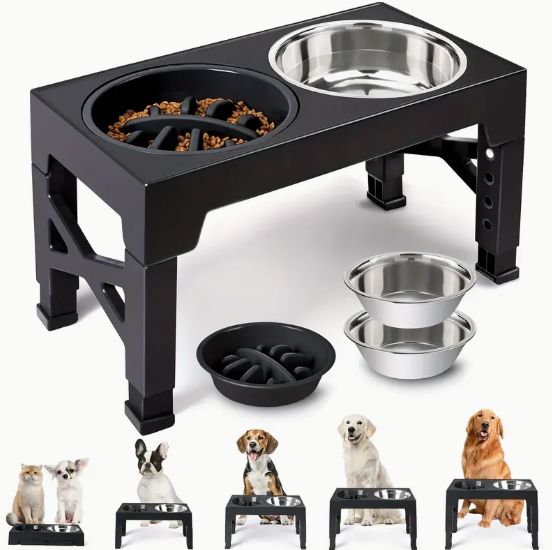
A specially designed dog food bowl with maze-like ridges that forces dogs to eat slower.
Why It Sells: It addresses a real health concern – eating too quickly can cause bloating or digestion issues in dogs. These bowls make mealtime a fun challenge and improve digestion. Many vets recommend them, so pet owners actively search for them.
Target Audience: Dog owners, particularly those with fast-eating breeds (e.g. Labradors, Beagles) or large dogs prone to bloat. Also any pet owner who wants to enrich their dog’s feeding time.
Dropshipping Tips: Usually made of plastic or silicone. Wholesale cost can be $3–$5, and they retail around $15–$25. Offer different sizes for small vs. large dogs if possible, and mention the capacity (cups of food it holds). They come in different maze patterns – having a couple of style options could help if you have a standalone pet store.
Marketing: Use before/after timing of a dog eating normally vs with the bowl to show how it prolongs feeding by X minutes.
Upsell Opportunity: Sell with a food storage container or pet food scoop to complete the feeding setup. Alternatively, cross-sell to cat owners for wet food (there are slow feeder mats for cats too) if you have that in stock.
6.Dog Car Seat Cover (Hammock Style)
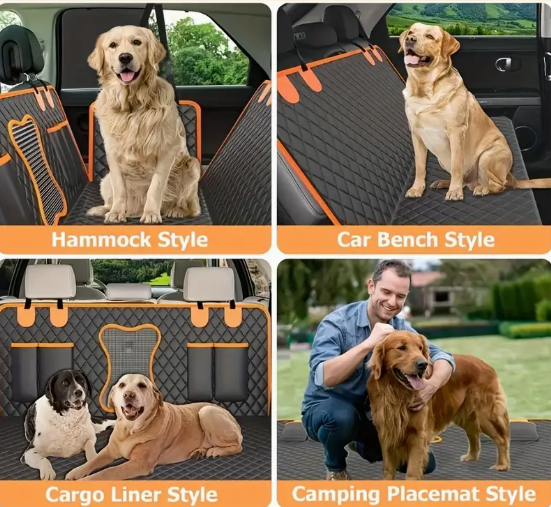
A waterproof car seat cover for the backseat that often hooks to front and back headrests, creating a hammock to protect seats from fur, dirt, and scratches.
Why It’s a Great Product: Pet travel is common – whether vet visits or road trips – and cars can get very dirty or even damaged. This cover is a lifesaver for keeping the car clean and pets safe (many have nonslip and even seat belt openings for harnesses). It’s a practical, high-perceived-value item.
Target Audience: Dog owners who take their dogs in the car (which is a lot of dog owners!). Especially those with larger dogs or active/outdoor dogs that get messy. Also a popular gift for dog owners who just got a new car.
Dropshipping Advice: There are standard and premium versions (premium ones have side flaps, extra padding, etc.). A decent quality one wholesale ~$15–$20, can retail $45–$60. Focus on heavy-duty fabric, waterproofing, easy cleaning, and universal fit in product description. Include images of the cover installed in a car for clarity.
Shipping Notes: It’s relatively heavy/bulky, so factor that in – free shipping is still doable if priced right, but perhaps build some cost into item price. If your supplier has US/Euro warehouses, prefer those for faster delivery due to size.
Upsells: Offer a dog seat belt harness or car window shade (for long trips) as add-ons. A neat idea is bundling a pet travel kit (portable water bowl, waste bag dispenser, etc.) for road warriors with pets.
7.Pet Travel Water Bottle
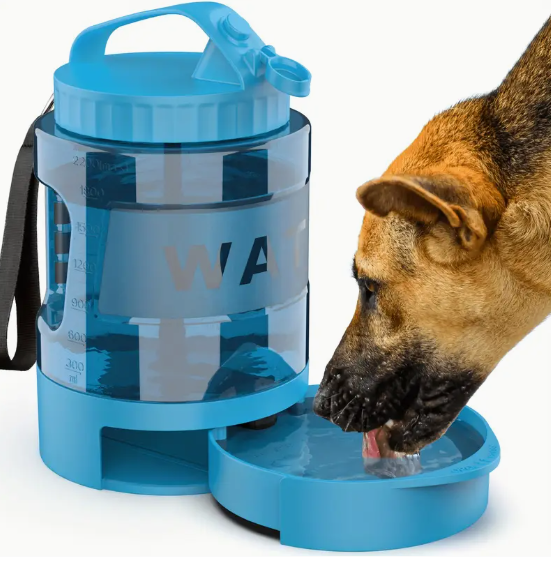
A portable dog water bottle with attached bowl or cup, designed for walking/hiking.
Why It’s a Must-Have: Hydration on the go for pets is important, and these bottles solve the problem of how to easily carry and dispense water for your dog. Many designs have a flip-out trough that collects excess water back into the bottle – very handy and reduces waste. They’re popular among hikers and city dog-walkers alike.
Target Audience: Dog owners who take their pets outdoors – whether on daily walks, park visits, hikes, or travel. Cat owners who travel with cats could use it too, but dogs are primary.
Dropshipping Tips: Small and lightweight, usually 350ml to 550ml capacity bottles. Wholesale cost ~$4–$6, retail around $15–$25 depending on size and design. Offer a couple of colors (usually come in blue, pink, white). Market the convenience and leak-proof design. A strap or carabiner on it is a plus (easy to carry hands-free).
Shipping: Very straightforward – just a plastic bottle. Should be cheap to ship; offer free shipping if you can.
Upsell Idea: Pair with a collapsible pet food bowl (for those longer trips where feeding might happen) or a waste bag dispenser (since anyone walking a dog likely needs to pick up poop – a reality of pet ownership). These small upsells complement the outing theme.
8.Pet Grooming Glove
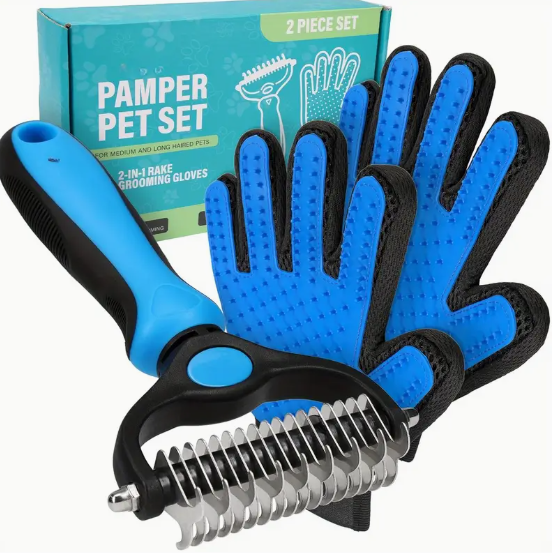
A grooming glove with soft rubber nubs that collects loose fur when you pet the animal.
Why It’s on the List: It’s an older hit product but still very much relevant. It turns grooming into a bonding activity rather than a chore, which pet owners (and pets) love. Many cats and dogs that hate brushes will allow a glove. It also doubles as a de-shedding tool that doesn’t look intimidating.
Target Audience: Owners of cats or dogs that shed, especially those whose pets dislike brushes. Also great for horses (there’s a subset of buyers who use it on horses).
Dropshipping Advice: Typically costs $1–$3 from suppliers and retails for $9.99–$15 (often as a pair of gloves, or single glove). Emphasize ease of use and how it mimics petting – which pets already enjoy. Show before/after or how much fur it collects with a simple image. It’s a cheap item, so consider volume deals (“Buy 2 get 1 free” to have spares or one for each hand).
Upsell: Obvious pair with the hair remover roller (#2 above) – one removes hair from the pet, the other from furniture. Bundle “Shedding Solution Kit” for a discount. Also, you can cross-sell pet shampoo or other grooming tools if you have those in your store.
9.Cat Backpack Carrier (Bubble Backpack)
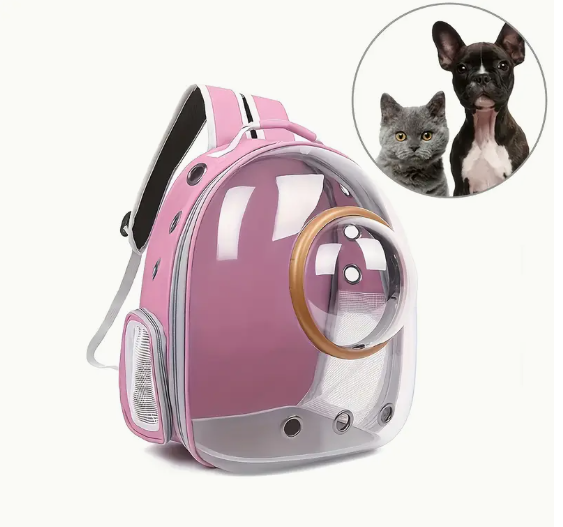
A pet carrier backpack with a clear bubble window for the pet to look out.
Why It’s a Trending Product: These “space capsule” backpacks became an Instagram sensation for cat owners and small dog owners. They’re not just cute – they let pets observe the world safely, which is great for anxious pets. Urban pet owners love them for hands-free transport on walks or commuting.
Target Audience: Primarily cat owners, and owners of small dog breeds or rabbits/ferrets even. Young pet owners (20s-30s) who are active on social media are a prime demographic – they enjoy the quirky style.
Dropshipping Tips: This item has a high perceived value. Wholesale around $15–$25 depending on quality; retail can be $49.99 up to $79.99 for premium models. Highlight features: ventilation (very important – multiple air holes, breathable mesh), weight capacity, and comfort (padding for wearer and pet). Use lifestyle images of someone wearing it with a cat inside gazing out the bubble – that visual is a selling point in itself.
Shipping Consideration: It’s bulky and not collapsible. Make sure you have ePacket or reasonable shipping solution – sometimes available via local warehouses. Some assembly may be required (attaching the bubble), so ensure instructions are included.
Upsell Idea: Offer pet harness & leash for taking the pet out safely when you reach the destination, or a portable litter mat if targeting cat owners traveling (there are foldable litter boxes/pads). At minimum, upsell a set of replacement bubble covers or different tinted bubbles if your supplier sells them – enthusiasts might like customization.
10.Snuffle Mat (Nose Work Feeding Mat)
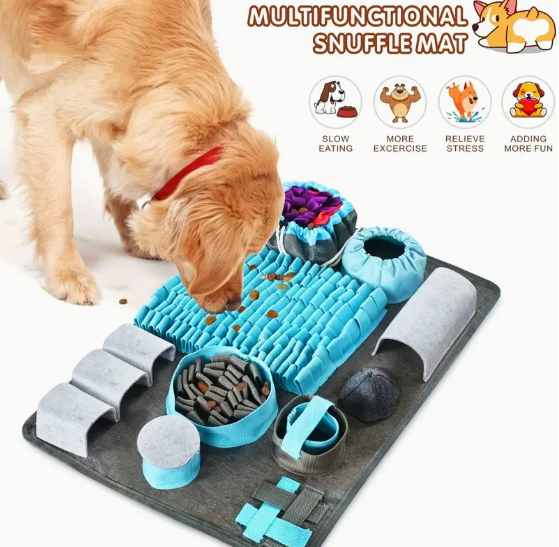
A snuffle mat for dogs (and cats) – basically a mat with fleece strips or pockets where you can hide treats or kibble, and the pet has to sniff and forage to find them.
Why It’s a Best-Seller: It turns mealtime or treat time into a mentally stimulating game for pets. With more pet owners understanding the importance of enrichment, snuffle mats have become very popular. They help slow down fast eaters and tire out dogs mentally.
Target Audience: Dog owners especially, from puppy owners (burn off energy) to senior dog owners (gentle enrichment). Also some cat owners use them for treats. Perfect for anyone whose dog gets bored or anxious – sniffing is soothing for dogs.
Dropshipping Advice: Common designs look like mats with felt grass or flowers. Wholesale cost ~$5–$8, and they retail $19.99–$29.99. Emphasize benefits like stress relief, slower eating, and training utility. Provide care instructions (most are machine washable, which is a plus to mention).
Marketing Tip: Educate customers if needed: explain what a snuffle mat is and how to use it – this can be done via a short video or an infographic image on your site. Many will find it cool once they understand it.
Upsells: Since it’s about treats, upsell some all-natural dog treats (if you have a partnership or supplier) to hide in the mat. Or pair it with the slow feeder bowl – pitch as “complete set to conquer fast eating and boredom.” Another idea: a dog puzzle toy – those puzzle feeders are in the same category of enrichment.
💻 Best Dropshipping Products for Tech & Electronics
Tech gadgets and electronics are perennial favorites for dropshippers, as there's always a new cool device or accessory coming out. In 2025, many tech products overlap with lifestyle improvements (smart home devices, phone accessories) and content creation (thanks to the influencer economy). When dropshipping tech, focusing on accessories and lower-cost gadgets (instead of high-end electronics) is wise for beginner-friendly margins and fewer support issues. Here are 10 of the best tech items to consider:
1.Selfie Ring Light (with Tripod)
2.Wireless Earbuds (Bluetooth Earphones)
3.Magnetic Car Phone Mount
4.Mini Portable Projector
5.Bluetooth Tracker (Key Finder)
6.Smartwatch (Budget Fitness Tracker)
7.High-Capacity Power Bank
8.Car Vacuum Cleaner (Portable)
9.Mini Drone with Camera
10.Smart Plug (Wi-Fi Outlet)
1.Selfie Ring Light (with Tripod)
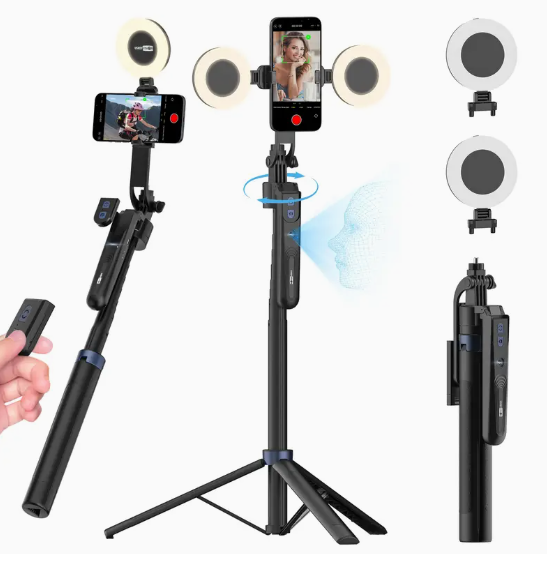
A LED ring light, often with an extendable tripod and phone holder, used for selfies, vlogging, or video calls.
Why It’s Booming: With remote work and the creator economy still thriving, good lighting is in demand for Zoom calls, TikToks, YouTube, etc. Ring lights became a staple for influencers and have now gone mainstream for anyone wanting flattering light.
Target Audience: Content creators (TikTokers, YouTubers, streamers), remote workers and students (for video conferencing), and even makeup artists (for better lighting).
Dropshipping Tips: Options range from small 8-inch desktop rings to 18-inch studio rings. A popular choice is a 10" ring with tripod, which wholesales ~$8–$12 and retails $25–$40. Emphasize features like adjustable color temperature (white/warm light) and brightness levels. If it comes with a Bluetooth shutter remote, mention that too.
EO Angle: Highlight compatibility with TikTok trends and how ring lights are essential for professional-looking videos – this taps into a large search volume.
Upsell: Offer an additional phone tripod (mini one for desktop) or a green screen backdrop if targeting content creators, as suggested by Shopify’s bundling tip. A smartphone lapel microphone could also pair well for the aspiring influencer.
2.Wireless Earbuds (Bluetooth Earphones)
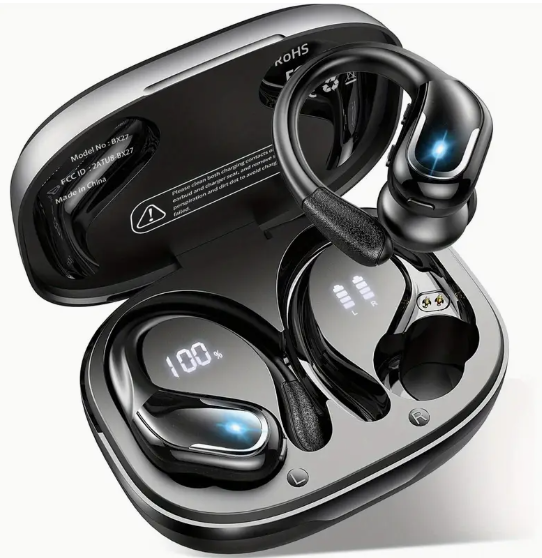
Compact Bluetooth earbuds with charging case, offering a budget alternative to name brands.
Why They Sell: Not everyone wants to pay $150+ for AirPods. Many quality earbuds in the $20–$50 range have emerged, and consumers are eager for affordable wireless audio. They’re small, everyday tech items that appeal to a wide audience – music lovers, commuters, gym-goers.
Target Audience: Practically everyone with a smartphone – but to narrow it: students, young adults, athletes (look for sweatproof features to target this subset), and travelers.
Dropshipping Advice: Tons of generic models are available. Look for suppliers with good reviews on sound quality and battery life (aim for at least 3-4 hours per charge, with case recharges extending to 12-20 hours). Wholesale might be $8–$15; retail around $29.99 is a sweet spot.
Marketing: Focus on value – “All the features of premium earbuds at a fraction of the price.” Highlight features like touch controls, noise isolation, and built-in mic for calls.
Branding Tip: Consider ordering a batch with custom branding (many suppliers offer OEM logos on the case) if you want to create a branded feel – though that’s advanced, it can differentiate your store.
Upsells: Include a silicone protective case (some with carabiner for the charging case) or memory foam ear tips as add-ons. Another idea: offer a wireless charging pad if the case supports wireless charging.
3.Magnetic Car Phone Mount
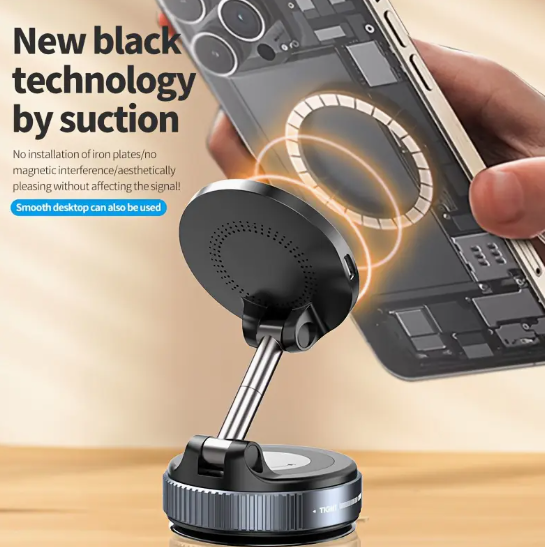
A magnetic phone holder for car dashboards or vents.
Why It’s a Consistent Seller: As cars don’t universally come with phone navigation screens, many people use their phones for GPS. A secure, easy-to-use mount is essential for safety and convenience. Magnetic mounts (with a metal plate on the phone or case) are popular for their simplicity.
Target Audience: Drivers of any kind – commuters, Uber/Lyft drivers, road-trippers. Essentially anyone with a car and a smartphone (so, a huge market).
Dropshipping Tips: There are vent mounts, dash/windshield mounts, CD-slot mounts – vent mounts are popular for ease, but have your listing make clear what type it is. These cost as little as $1–$3 and retail $9.99–$15. That margin is decent if volume is high; often this item could be a great low-cost upsell on a car gadget store.
Quality Check: Ensure strong magnet and a stable grip (some cheap ones fall off vents easily). Look for ones that come with multiple metal plates (for multiple devices).
Upsell Opportunities: Sell in a 2-pack (one for each car, or one for driver and passenger). Or pair it with another car accessory like a dual USB car charger or fast-charging cable – a logical add-on since mount users likely use GPS which drains battery.
4.Mini Portable Projector

A mini LED projector (often palm-sized or slightly larger) that can project movies or presentations on the wall.
Why It’s Hot: The idea of a “cinema at home or anywhere” is very appealing. These mini projectors have become more affordable, making them a trendy gadget for movie nights, gaming, or even business presentations on the go. They often feature in holiday gift guides and TikTok “cool gadgets” videos.
Target Audience: Young adults, students (for dorm movie nights), families (backyard movies), travelers (compact entertainment), and professionals (for impromptu presentations).
Dropshipping Advice: Focus on those that connect via HDMI/USB or even directly to smartphones. Key specs to mention: resolution (many are 720p or support 1080p input), projection size, and built-in speaker (managing expectations that sound may not be theater-quality without external speakers). Wholesale costs can be $30–$50; retail often $79–$120 depending on spec. So this is a mid-range item – highlight the value (cheaper than a big TV, and portable).
Marketing Angle: Use lifestyle imagery – e.g. projector casting a movie in a cozy room or outdoor setting – to spark imagination.
Shipping Consideration: It’s electronic and slightly heavier; insurance for shipping might be good. Offer tracking and consider using a faster shipping method given the price point.
Upsells: Offer a tripod stand (many mini projectors have a tripod mount) or a projector screen (foldable screen cloth) for those who want the full setup. You could also upsell an HDMI wireless dongle (like ones that cast phone to projector) if your projector isn’t smart.
5.Bluetooth Tracker (Key Finder)

A small Bluetooth tracking tag you attach to keys, wallet, pet collar, etc., and use your phone to locate it (similar to Tile or AirTag alternatives).
Why It Sells: We all lose things. These trackers solve a universal problem in a techy way. With Apple’s AirTag bringing awareness, many non-Apple users want a comparable device. Also, privacy-concerned or budget buyers seek non-Apple, plus these can be used on any device via an app.
Target Audience: Virtually anyone who carries keys or misplaces items – but especially busy individuals, travelers (luggage tracking), pet owners (though specialized pet trackers use GPS, some still use Bluetooth for short-range). Also, parents might put one in a kid’s backpack.
Dropshipping Tips: Common ones are coin-sized and use a CR2032 battery. Wholesale is very low ($1–$3); they often retail $9.99–$19.99. You can sell them in bundles (“Pack of 4 trackers”) because people usually want multiple – this increases average sale. Make sure to note the range (usually ~30-50m) and that it’s a Bluetooth tracker (not GPS) to set correct expectations. Also mention if it makes a sound, has a replaceable battery, etc.
Upsell Idea: Simply encourage buying multiple: e.g. a discount on 2+ or preset multi-packs. Or pair with a keysmart organizer (a gadget to hold keys compactly) if you carry those.
6.Smartwatch (Budget Fitness Tracker)
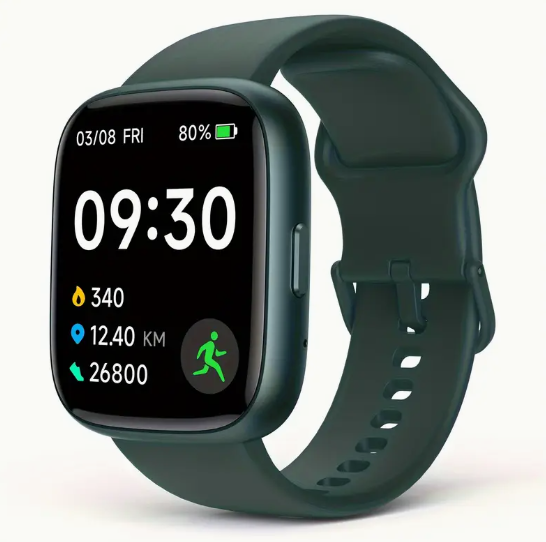
An affordable smart watch or fitness tracker that monitors steps, heart rate, sleep, and shows smartphone notifications.
Why It’s a Good Product: Fitness tracking and smart wearables have high demand, but not everyone can afford an Apple Watch or Garmin. Many look for budget-friendly options that give basic functionality – which is where dropshippable smartwatches excel. The technology in even $20 watches now is quite impressive.
Target Audience: Fitness beginners, budget-conscious consumers, kids/teens (parents might buy cheaper smartwatches for them), and those new to wearables. Also people who prefer not to wear an expensive watch for work or travel and want a secondary device.
Dropshipping Tips: Choose a model with a sleek design and an app with decent reviews (often these watches use generic apps like Da Fit or similar – you might find user feedback on app stores). Wholesale might be $10–$15; selling at $35–$50 is reasonable. Highlight key features: step counter, heart rate monitor, waterproof rating (IP67 or better ideally), battery life (often 5-7 days). Avoid making medical claims, but you can mention wellness features like sleep tracking.
Quality Check: Electronics can have higher return rates – make sure supplier has good QC and warranty (some offer 6-month supplier warranty; mention it to build trust).
Upsell Opportunities: Offer extra watch bands/straps (maybe different colors or materials) as many are interchangeable with common connectors. Also, you could bundle a wireless earbuds (from item #2) in a fitness-themed combo deal (listen to music + track workouts).
7.High-Capacity Power Bank

A portable charger (e.g. 10,000mAh or 20,000mAh power bank) for phones and devices.
Why It’s Evergreen: As long as people have mobile devices, power banks are essential, especially for travelers, outdoor enthusiasts, or during power outages. Newer ones with fast charging or slim designs catch attention. The demand is steady and huge worldwide.
Target Audience: Everyone with a smartphone – but key segments: travelers, commuters, students (long days on campus), campers, and anyone in regions with unreliable power.
Dropshipping Advice: Focus on reliable quality (batteries can be a hazard if poor quality – ensure supplier compliance with safety certs). Wholesale cost depends on capacity and features ($5-$15 range), retail usually $19.99–$39.99. Sweet spot is around 10k mAh for portability vs capacity. Mention clearly the mAh (capacity), how many charges of a phone it provides, and outputs (e.g. “2 USB outputs, 1 USB-C with PD fast charge”). Also if it supports newer standards like QuickCharge or Power Delivery, highlight that.
Shipping Note: Contain lithium batteries, which can have special shipping requirements. Ensure your supplier can ship them properly (often via specific lines, possibly slower shipping). Communicate realistic delivery times if so.
Upsell Idea: Include a 2-in-1 charging cable (multiple connectors) so users have everything needed. Or pair with a solar charger panel for outdoorsy users (if available, though those can be niche). Another is to upsell a protective case if the power bank is fancy or needs one.
8.Car Vacuum Cleaner (Portable)
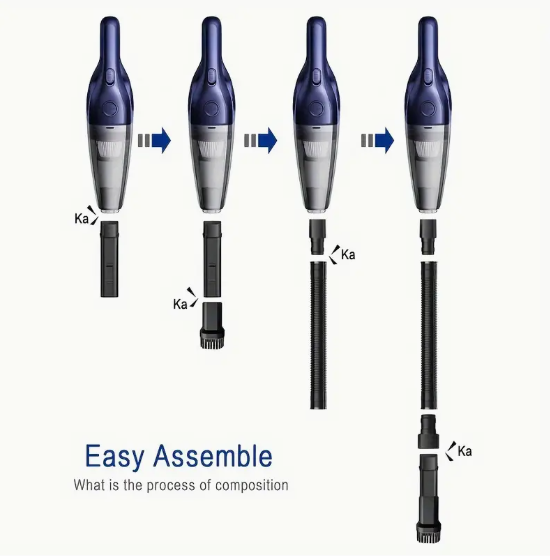
A compact handheld vacuum for cleaning car interiors, often powered via 12V car outlet or rechargeable.
Why It’s In Demand: Cleanliness on the go is valued, and people want to maintain their vehicles easily. A small vacuum that can get into crevices of cars is super practical. This was even highlighted as a trending car accessory by Shopify. It’s also a product that can be demonstrated well in video ads (showing crumbs getting sucked up).
Target Audience: Car owners, especially those who take pride in their car’s appearance – think rideshare drivers, parents with kids (who make messes), pet owners who travel with pets, etc. Also, it can double for small apartment cleaning or desktop cleaning, so apartment dwellers might like it too.
Dropshipping Tips: There are corded versions (plugs into cigarette lighter) and cordless. Cordless (battery) ones have higher appeal but ensure decent suction power. Wholesale ~$10–$20, retail $29.99–$59.99 depending on power and features. Emphasize attachments (like crevice tool, brush head) and suction strength (some list in thousand PA). Include specs like “5,000Pa suction” or similar if impressive.
Marketing: Show before/after on car mats or seats. Highlight convenience (fits in car trunk, always available for quick clean).
Upsell Opportunities: Offer a car cleaning kit bundle – e.g. include microfiber cleaning cloths or car dust brushes. Another great pair: car trash can (as seen on Shopify list, car trash bins are popular). Sell both to target the neat-freak audience.
9.Mini Drone with Camera
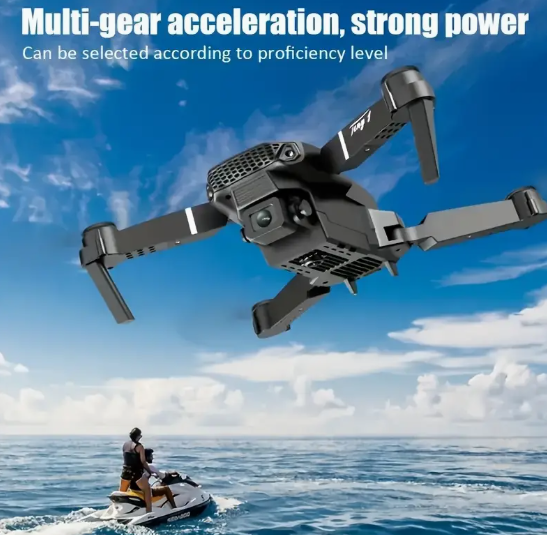
A small quadcopter drone equipped with a camera (usually 720p or 1080p) for casual flying and aerial photos/videos.
Why It’s Cool: Drones fascinate people, and mini ones make the tech accessible. They’re often marketed as toys or beginner photography drones. They’ve been popular gift items for the past few years and continue to hold interest, especially as camera quality improves at lower prices.
Target Audience: Tech enthusiasts, teenagers, adults who want a fun gadget, travelers (for travel shots but who can’t afford pro drones), and gift-givers (dads, grads, etc.). Also STEM parents might get mini drones for kids to spark interest in science/aviation.
Dropshipping Advice: There’s a wide variety – many mini drones fold up and have features like altitude hold, one-key return, etc. Wholesale can be $20–$30; retail around $50–$80 for decent ones. Make sure to adhere to any regulations note (e.g. high-end drones have restrictions, but mini ones usually under weight limits). Provide honest info on range and battery life (often ~10 min flight per charge for small ones).
User Guidance: Include or link to tutorial videos or manuals, as some buyers might be new to drones – reducing returns if they know how to use it. Shipping: Drones contain electronics and possibly spare batteries; ensure compliance with shipping rules for lithium batteries.
Upsell: Sell extra drone batteries (most drones have swappable batteries – offering extras means more flight time and more revenue) or replacement blade propellers as these can break in crashes. You could also upsell a storage case if not included.
10.Smart Plug (Wi-Fi Outlet)
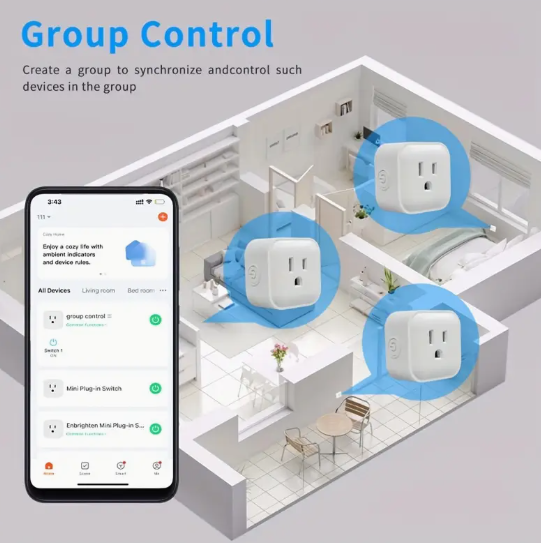
A smart plug that lets users control power to any device via an app or voice (with Alexa/Google Home).
Why It’s a Good Seller: Smart home gadgets are increasingly popular as they make everyday life easier. A smart plug is an entry-level smart home device – inexpensive, easy to use, and instantly useful (e.g., turn lights on/off on schedule). Many people buy several once they see the convenience.
Target Audience: Homeowners or renters looking to automate their home, gadget lovers, people with mobility issues (who benefit from voice-controlled outlets), and energy-conscious individuals who want to schedule off appliances to save power.
Dropshipping Tips: These typically use Wi-Fi and an app like Smart Life or proprietary ones. Wholesale cost ~$5–$8 each; retail usually $15–$25 per plug. You can also sell in multi-packs (common since people rarely stop at one). Make sure to note if it’s 2.4GHz Wi-Fi only (many are). Emphasize ease: just plug in, connect app, and you can control lamps, coffee makers, etc. If it works with Alexa/Google Assistant, highlight that integration.
Region Note: Plugs are region-specific (US, EU, UK, etc shapes differ). Target your market and ensure you source the correct plug type for your target customers or have variants.
Upsell Idea: Offer a pack of 4 smart plugs at a slight discount to encourage bulk. Or cross-sell other smart devices like smart bulbs or a smart LED strip (if in your catalog) to capture those building a smart home environment.
💪 Best Dropshipping Products for Health & Wellness
Health and wellness products cover fitness gear, personal health devices, and wellness accessories. This category saw a huge boost with more people working out at home and focusing on self-care. Products that help solve health problems or enable convenient at-home exercise can do extremely well. Here are 10 winning dropshipping products in health and wellness for 2025:
1.Posture Corrector Brace
2.Deep Tissue Massage Gun
3.Yoga Mat (Eco-Friendly)
4.Resistance Bands Set
5.Acupressure Mat and Pillow Set
6.Motivational Water Bottle (with Time Markers)
7.Bluetooth Sleep Headphone Headband
8.Hand Grip Strengthener
9.Neck and Shoulder Massager (U-Shaped)
10.Smart Jump Rope (Digital)
1.Posture Corrector Brace

An adjustable posture corrector that pulls the shoulders back to improve posture.
Why It’s Profitable: With so many working from home (often hunched over laptops) and increased health awareness, posture devices became popular. They promise relief from back/neck pain by aligning posture. Many people see it as a simple fix or a training aid to sit/stand straighter.
Target Audience: Office workers, students, gamers – anyone sitting long hours. Also older adults with slouching habits. Works for both men and women, typically ages 18–55.
Dropshipping Tips: These braces are often size-inclusive (one-size with lots of straps) or come in sizes; ensure you clarify sizing. Wholesale cost around $3–$6, retail usually $19.99–$29.99. Market it as an aid, not a medical device – e.g., “gentle support for better posture.” Include usage instructions (15-30 minutes a day to start, etc.) to manage expectations (it can feel uncomfortable if overused initially).
Upsell: Suggest a memory foam lumbar support cushion for their chair or a standing desk mat – things that complement posture improvement in daily routine.
2.Deep Tissue Massage Gun
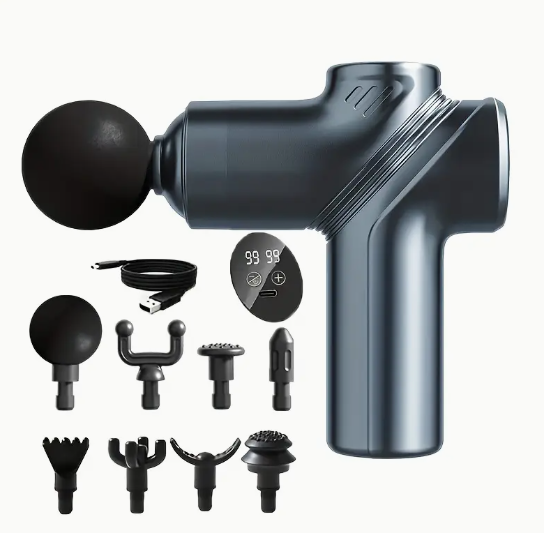
A percussive massage gun for muscle relief and recovery.
Why It’s a Top Item: Inspired by higher-end brands (Theragun, etc.), many affordable massage guns emerged and went viral as must-have recovery tools. They’re loved by athletes, fitness buffs, and those with muscle tension. The promise of relieving knots and aches at home is very attractive.
Target Audience: Athletes, gym-goers, physical job workers, and people with chronic muscle stiffness (like neck or back pain sufferers). Also a popular gift for dads, trainers, etc.
Dropshipping Advice: This is a higher-ticket item (wholesale $30–$50, retail $80–$150 depending on quality). Look for models with multiple heads and adjustable speeds. Emphasize battery life and motor power (e.g. “20-speed levels, 4-hour battery”). Include a carrying case if possible as it adds value.
Marketing: Use testimonials or video demos showing relief (like someone using it on sore legs after running). Avoid making medical claims, but phrases like “promotes muscle recovery and relaxation” are safe.
Shipping: It’s heavy, so factor shipping cost. Possibly use local warehouses if available.
Upsells: Offer a foam roller or yoga stretching strap as complementary tools for a full recovery kit. Maybe a guide to stretches as a free digital add-on to make the purchase feel more valuable.
3.Yoga Mat (Eco-Friendly)

A high-density yoga mat, possibly eco-friendly material (cork, TPE, etc.), for home workouts and yoga.
Why It Still Sells: Yoga and home workouts remain extremely popular. Many customers seek better mats for cushioning or non-slip surfaces. Eco-friendly or extra-thick mats differentiate from the cheap ones. Even with heavy competition, new designs (like alignment grids) or materials can stand out.
Target Audience: Yogis, Pilates enthusiasts, home exercisers, and beginners building a home gym. Ages widely vary; both women and men, often 18–50. Also, people rehabilitating injuries use mats for floor exercises.
Dropshipping Tips: Shipping mats can be costly due to bulk, so consider focusing on niche (like travel foldable mats or kid-sized mats) if shipping is a concern. Wholesale cost anywhere from $5 (basic PVC) to $15 (thick eco materials). Retail $20–$50+. Highlight thickness (e.g., 6mm vs 10mm), material benefits (non-toxic, non-slip), and include a carry strap or bag if possible.
SEO/Marketing: The keyword space is crowded, but aligning with trends like “eco-friendly yoga mat” or “non-slip exercise mat for home” can help. Real photos (yoga in nature or at home) appeal to the target audience’s aspirational use.
Upsell: Offer a yoga accessories kit – e.g., yoga blocks and strap, or a gym bag that fits the mat. If eco angle, maybe cork yoga block upsell. Or pair with a workout guide eBook (digital product) focusing on yoga routines or stretches on the mat.
4.Resistance Bands Set
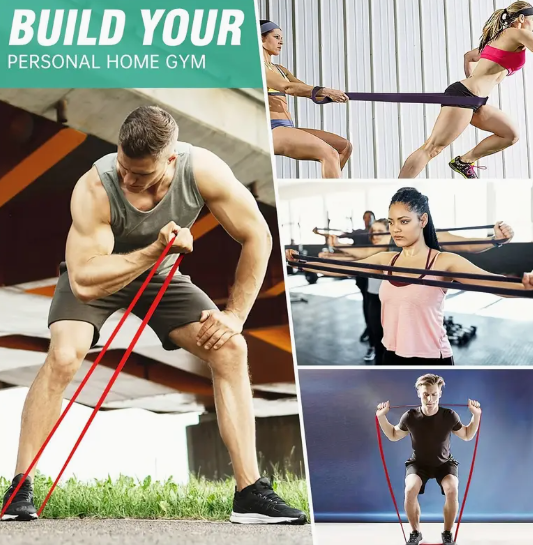
A set of resistance bands, often with multiple tension levels and attachments (handles, door anchor).
Why It’s a No-Brainer: Resistance bands surged in popularity for home workouts (especially during lockdowns) and remain staples for strength training, physical therapy, and travel exercise. They’re lightweight, versatile, and inexpensive, making them an ideal dropshipping item with broad appeal.
Target Audience: Home workout enthusiasts, travelers (who want portable gym gear), rehab patients, beginners who want to ease into strength training, and women (resistance band booty workouts are a big trend).
Dropshipping Tips: Sets usually include several color-coded bands (like 10-50 lbs resistance), handles, door anchor, ankle straps, and a carry bag. Wholesale around $5–$8 for a full set, retail $20–$30 typically. Quality matters (snap risks), so highlight latex durability or if they’re latex-free (for allergy). Provide safety tips (not stretching beyond limit, checking for wear) to reduce liability and show you care.
Marketing: Show a variety of exercises possible (maybe an infographic or mention the list of exercises: rows, curls, leg extensions, etc. to illustrate versatility).
Upsell: Pair with a workout guide (digital or printed posters) demonstrating band exercises – adds value and costs little to provide. Also, upsell a yoga mat or foam roller for post-workout stretching.
5.Acupressure Mat and Pillow Set
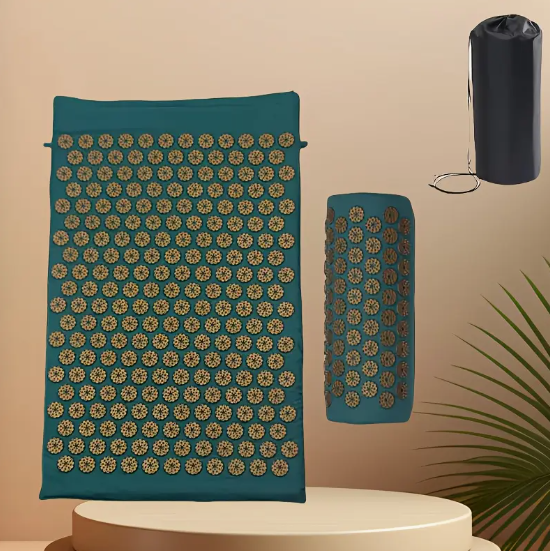
A spiked acupressure mat (with hundreds of plastic spikes) along with a neck pillow, used for relaxation, back pain relief, and improving circulation.
Why It’s in Demand: Often called a “bed of nails” mat, it gained popularity as a home wellness tool. Users report stress relief, better sleep, and muscle tension release. It’s a bit niche but has a devoted following and high margin potential.
Target Audience: People with back or neck pain, stress sufferers, yoga/meditation enthusiasts, and biohackers looking for natural pain relief methods. Age 25-60 usually. Also good for office workers to lie on after a day at the desk.
Dropshipping Tips: Comes in sets with mat + pillow. Wholesale ~$10–$15, can retail $39.99–$59.99. Emphasize benefits and the science of acupressure (without overclaiming). Explain that initial discomfort leads to relaxation as endorphins release – setting user expectation is crucial so they’re not alarmed by the sensation. Choose mats made with skin-friendly materials (cotton covers, non-toxic spikes).
Content: Use calm, spa-like imagery or videos of someone calmly laying on it (versus scary bed-of-nails impression). Share testimonials or star ratings if you have them.
Upsell Idea: Offer a lavender eye mask or essential oil to use while on the mat (enhancing relaxation). Or a massage ball for deeper trigger point therapy as a complementary item.
6.Motivational Water Bottle (with Time Markers)
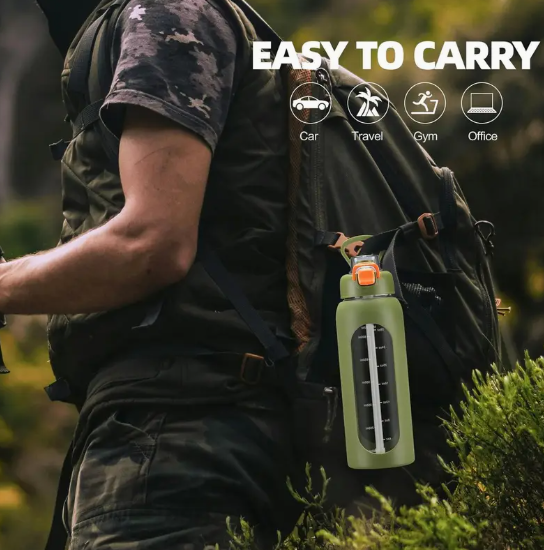
A large water bottle (1L/2L) marked with time goals (e.g., 8am, 9am, etc. with encouraging phrases) to encourage drinking water throughout the day.
Why It Sells: This was a viral wellness product – it turns the simple act of drinking water into a motivational challenge. With increased focus on hydration for health and fitness, many people love having a bottle that nudges them to meet their daily water intake.
Target Audience: Fitness enthusiasts, office workers (to keep on desk), students, and anyone into health challenges. It skewed more female in marketing due to the often bright colors and quotes, but hydration is universal. Great gift item too (for that friend who “doesn’t drink enough water”).
Dropshipping Advice: These are usually plastic (BPA-free Tritan) in 64 oz (2L) or 32 oz sizes with a straw and handle. Wholesale $4–$7, retail $15–$25. Highlight features: leakproof lid, carry strap, the motivational phrases. The trend factor is the printed times/phrases – ensure they’re correctly printed and maybe show a close-up in images.
Shipping: Bulky but lightweight. If shipping overseas, check dimensional weight. Possibly work with local suppliers to ship domestically for speed.
Upsells: Sell along with fitness journals (track water, meals, exercise) or a fruit infuser insert if the bottle supports adding fruit for flavor. Another idea: pair with a set of resistance bands or gym towel to tie into an overall fitness theme.
7.Bluetooth Sleep Headphone Headband
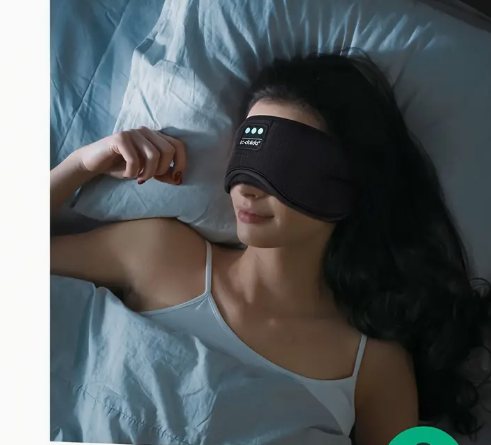
A soft headband with built-in Bluetooth headphones, used for comfortable listening to music or white noise in bed (also doubles as a sleep mask if pulled over eyes).
Why It’s Gaining Popularity: Many people listen to calming music, podcasts, or white noise to sleep, but regular earbuds hurt and traditional headphones are bulky. This solves that problem. It’s also great for side-sleepers since it’s flat against the ear. With rising anxiety and sleep issues, products aiding better sleep are hot.
Target Audience: Individuals with insomnia or anxiety, frequent travelers (to sleep on planes), shift workers, and even people who do yoga/meditation with it. Also, partners of snorers use it to drown out noise. Age range 18-50 often.
Dropshipping Tips: Ensure the headband is adjustable or stretchy to fit various head sizes and that the speakers are removable (for washing the band). Wholesale cost ~$6–$10; retails around $19.99–$29.99. Highlight battery life (should last through the night ideally ~8 hours) and sound quality for music vs just noise. Many come in different colors. Mention it doubles as a workout headband too (some use it for running).
Marketing Angle: Emphasize comfort and better sleep – maybe cite how using calming audio can improve sleep quality (without making medical claims). Use images of someone peacefully sleeping wearing it.
Upsell Opportunities: Cross-sell with a white noise machine or aromatherapy diffuser for a full sleep improvement set. Alternatively, offer a silk sleep mask (if the headband isn’t covering eyes) or memory foam earplugs for when they aren’t using the headband.
8.Hand Grip Strengthener

A finger and hand grip strength trainer, often an adjustable resistance squeezing tool or a set of silicone rings.
Why It’s Notable: Tradelle identified a finger grip strengthener as a viral product in early 2025 – it taps into both fitness and stress-relief markets. Climbing, guitar playing, improved handshake, rehab from injury – many angles make it appealing. Plus, it’s a simple, inexpensive gadget that people can fidget with at their desk (doubling as a stress reliever).
Target Audience: Rock climbers, martial artists, musicians, gamers (who want stronger hands for controller/keyboard), and folks recovering from hand injuries or looking to prevent stiffness (like seniors with arthritis, though need doc advice for that). Also office workers who might use it to avoid RSI and as a stress ball alternative.
Dropshipping Tips: There are adjustable ones with a spring (e.g., 10-60kg adjustable) and non-adjustable silicone rings of varying resistances. The adjustable ones wholesale ~$2–$4, retail $12–$20. Market it with specific use cases: e.g., “Great for climbers and guitarists to boost performance,” and “use at your desk to de-stress while strengthening grip.” It’s small – highlight portability (fits in pocket).
Content: Perhaps include a quick exercise routine (like how many squeezes per day) in product description to inspire use.
Upsell: Combine with a wrist strength gyro ball (another hand/forearm gadget) as a “Hand & Forearm Power Pack,” or a set of finger stretch bands (those rubber band-like tools to train extensor muscles). Also, a massage ball to roll out forearm tension could pair well.
9.Neck and Shoulder Massager (U-Shaped)
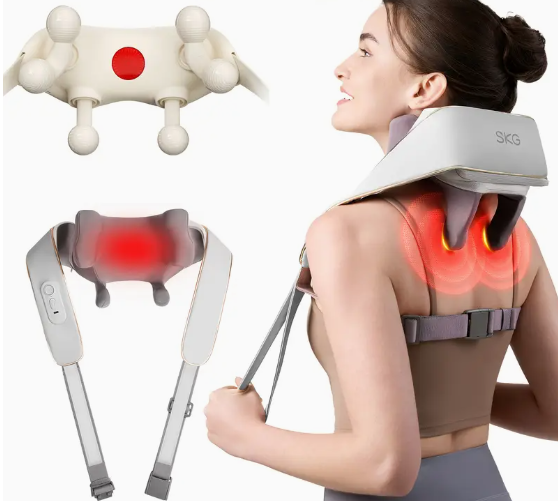
An electric neck and shoulder massager, often U-shaped to sit on the neck/shoulders, with optional heat and Shiatsu massage nodes.
Why It’s a Great Product: Who doesn’t have neck or shoulder tension these days – from phone use (text neck) to desk work. These devices give a deep tissue massage at home. They’ve been popular for a few years and continue strong, frequently appearing on gift recommendation lists for adults.
Target Audience: Office workers, drivers, the stressed and overworked, and people with mild chronic neck pain or stiffness. Age typically 25-65. Also popular as gifts for parents or family (“treat yourself” gifts).
Dropshipping Advice: Ensure the model has good reviews for durability (moving parts). Wholesale $20–$30, retail $59.99–$89.99. Emphasize features: bi-directional rotating nodes, heat function, speed settings. Many come with arm loops to adjust pressure – highlight that.
Marketing/Claims: Use relaxation and convenience angles – “massage anytime, while watching TV or at the office.” Avoid making medical claims like curing anything, but you can say “can help relieve sore muscles and stress.”
Shipping: Fairly heavy; likely need to charge shipping or build it into price and use a reliable courier. Perhaps target local shipping to avoid long waits for customers who might need it quickly if in pain.
Upsell: Offer a gel massage lotion or pain relief cream (if you have a supplier) to use after massaging, or bundle with a lower back massager or foot massager if you have multiple massage products, to encourage multi-buy (“complete home spa kit” idea).
10.Smart Jump Rope (Digital)

A smart jump rope that counts jumps, calories, or connects to a phone app to track workouts.
Why It’s on the Rise: Jump rope workouts are trending for their efficiency (great cardio, calorie burn) and minimal space requirement. A smart rope adds a tech twist, motivating users by tracking progress or even displaying count mid-air with LEDs in some fancy models. It aligns with the gamification trend in fitness.
Target Audience: Fitness enthusiasts, CrossFitters, people who prefer home workouts or quick HIIT sessions, and gadget lovers who like tracking stats. Also appealing to weight-loss audiences as jump rope is known for high calorie burn.
Dropshipping Tips: Several versions exist: some simply have a digital counter on the handle, others connect to apps via Bluetooth. Wholesale ~$8–$15 for decent ones; retail $30–$60 depending on features. Emphasize that it’s tangle-free (often they have ball bearings) and maybe comes with adjustable length for different heights. Highlight the tracking: “built-in counter shows your jump count, track your daily goal via the app” – this makes it superior to a $5 basic rope.
Marketing: Use dynamic imagery of someone jumping rope, mention benefits (improve coordination, full-body workout, portable gym etc.). Possibly cite how X minutes of jump rope equals Y minutes of jogging to drive interest.
Upsell Idea: Suggest a workout mat (jumping on a mat can reduce impact on joints) or sweat-resistant headband/wristbands for those intense sessions. Or pair with a smartwatch/fitness tracker to upsell a tech bundle for getting in shape.
👶 Best Dropshipping Products for Baby & Kids
Parents are big spenders when it comes to their children, and they value safety, convenience, and quality. The global baby products market is booming and expected to continue growing. Dropshipping baby and kids’ items can be rewarding, but trust is key – products must be safe and preferably tested. Here are 5 of the best baby/kid items to consider:
1.Ergonomic Baby Carrier (Baby Sling)
2.Stroller Fan (Portable Clip-On Fan)
3.Digital Baby Monitor (Wi-Fi Camera)
4.Silicone Baby Teething Toys
5.Diaper Bag Backpack
1.Ergonomic Baby Carrier (Baby Sling)

A wearable baby carrier (either a structured buckle carrier or a wrap sling) that lets parents carry infants hands-free.
Why It’s Popular: Baby carriers have become an essential for new parents – they enable bonding, soothe the baby, and allow mom or dad to get things done. Ergonomic designs that support baby's hips (M-position) and distribute weight evenly for the wearer are highly sought after.
Target Audience: New parents of infants (0-18 months generally), plus gift shoppers for baby showers. Modern parents, both moms and dads, are target since many carriers are unisex.
Dropshipping Tips: Prioritize safety – look for carriers with certifications or lots of positive reviews. Wholesale can be $15–$25, with well-known brands retailing $60–$100; as a non-brand you might price around $39.99–$59.99 for quality. Highlight features: newborn insert (if any), multiple carry positions (front inward, front outward, back carry), padded straps, breathable fabric. Also mention weight range (e.g. 7-45 lbs).
Content Angle: Emphasize the convenience (hands-free, calming a fussy baby) and ergonomic benefits for both baby and parent (e.g. “prevents back strain”). Use images of both a mom and a dad using it to broaden appeal.
Upsell Ideas: Offer a baby drool bib that wraps around the carrier straps (protects from baby chewing on it) or a pack of baby bandana bibs matching the carrier’s style. Another upsell: a portable stroller fan (next item, actually) which also complements baby outings.
2.Stroller Fan (Portable Clip-On Fan)

A mini portable fan that clips onto a stroller, car seat, or crib to keep babies cool. Often has flexible tripod legs or a strong clip.
Why It’s in Demand: Babies can easily get uncomfortable in heat. A stroller fan is a simple gadget that provides airflow and cooling, and many are designed to be safe for little fingers (foam blades or bladeless designs). Come summertime, these are lifesavers for outdoor walks.
Target Audience: Parents of babies and toddlers, especially in warm climates or summer season. Also useful for anyone wanting a portable fan (e.g., office desk), but marketed for baby is the niche.
Dropshipping Advice: Choose fans with rechargeable battery (USB charging) for convenience. Wholesale ~$5–$10, retail $19.99–$29.99. Highlight safety features (if blades are soft or caged well) because parents will worry about curious fingers. Note battery life (e.g., “lasts 3-6 hours on a charge”) and multi-use (stroller, car seat, tabletop).
Marketing: Use summery imagery of a fan on a stroller out in the park. Possibly quote a practical scenario: “Keep your baby breezy and sweat-free on summer strolls.” If it has night light or aromatherapy options (some do), mention it.
Upsell: Sell with a UV-protective stroller cover or sunshade extension – catering to summer/outdoor needs. Or bundle a baby sunscreen lotion (if you have an affiliate or drop-ship source for consumables) for a summer kit.
3.Digital Baby Monitor (Wi-Fi Camera)
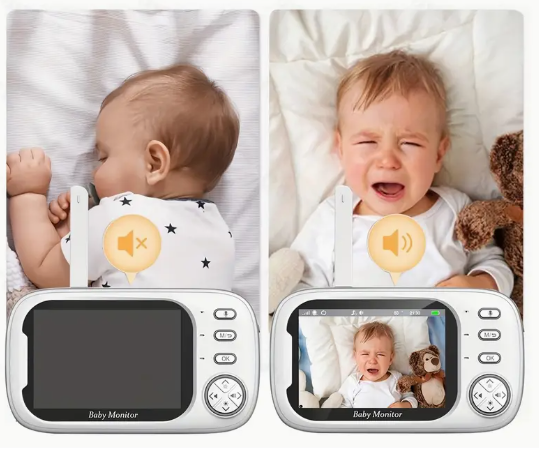
A baby monitor camera that connects to an app or dedicated receiver, allowing parents to watch and hear their baby remotely.
Why It’s Essential: Peace of mind – new parents want to keep an eye on their sleeping infant. Modern Wi-Fi monitors even allow viewing from anywhere (great for working parents or traveling). Features like HD video, night vision, two-way audio, and temperature sensors make them very appealing.
Target Audience: Parents of babies and toddlers, and gift buyers for baby showers (often a high-end gift). Tech-savvy parents especially appreciate Wi-Fi/app models, while some prefer standalone (non-WiFi) for privacy – could consider which to focus on.
Dropshipping Tips: This is a higher price tech item (wholesale $20–$40, retail $59–$129 depending on features). If Wi-Fi, ensure the app is reliable (check reviews) and mention security (some are concerned about hacking, so talk about encryption if applicable). If non-WiFi with a parent unit, highlight range (like “range up to 300m”).
Key Features to List: 1080p or 720p camera, night vision, two-way talk (soothing baby remotely), lullaby playback or night light (some models have these), motion/sound alerts, and battery life of the receiver if any.
Marketing: Emphasize safety and stress-relief: “Get more done while baby sleeps, knowing you can see and hear every peep.” Possibly cite that it’s like having an extra set of eyes.
Upsell Ideas: Offer a second camera discount (some parents use two for multiple kids/rooms). Or bundle with a smart plug to remotely turn on a nursery lamp or white noise machine from the same phone – a creative cross-category upsell.
4.Silicone Baby Teething Toys
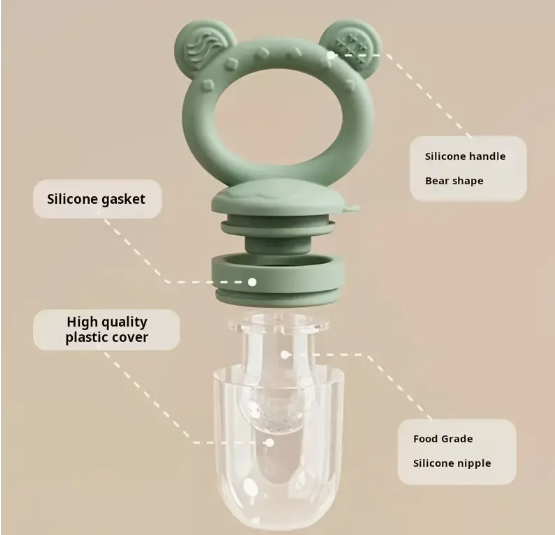
Safe, silicone teether toys (like teething rings, necklaces, or pacifier clips with chewable beads) for babies to soothe gum pain.
Why They Sell: Every baby goes through teething pain, and parents are desperate for relief solutions. Silicone teethers in fun shapes (animals, fruits) or wearable ones (like a teething mitten or mom’s necklace the baby can chew) are very popular. They’re inexpensive and often bought in multiples.
Target Audience: Parents of infants ~3-12 months (teething phase), and gift-givers (teethers are common in baby gift sets).
Dropshipping Advice: Ensure BPA-free, phthalate-free, food-grade silicone – safety absolutely must be stressed and guaranteed. Wholesale cost ~$1–$3 each depending on design, and typically retail $7–$15 each or in sets. It’s often good to sell as sets (e.g. a 3-pack of different shapes) to increase value. Highlight ease of cleaning (dishwasher safe or boil safe). If it has textures for gum massage, mention that.
Marketing: These are cute – use bright, baby-friendly imagery. Highlight how it keeps babies entertained while soothing gums, potentially saving parents sanity. Possibly mention pairing with a teething gel (but that’s a medical product, better not involve directly).
Upsell: Combine multiple teethers in a bundle (e.g., fruit themed set of 5) to encourage a higher purchase. Or cross-sell a pacifier clip (to attach teether and not drop it) or a bib (babies drool a ton when teething). A teething mitten (a glove baby wears to chew on) could be an upsell if you sell a classic ring; or vice versa.
5.Diaper Bag Backpack
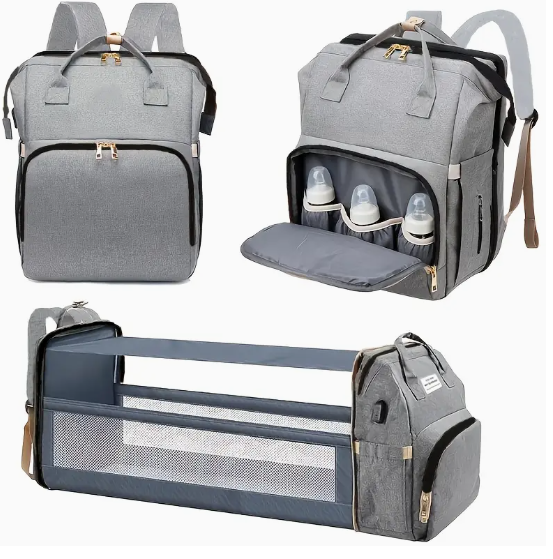
A multi-functional diaper bag in backpack form, often with USB charging port and stroller straps.
Why It’s a Best-Seller: Modern diaper bags look stylish and act like a mobile nursery. Backpack style is preferred because it frees hands and balances weight. Parents love bags with lots of organized pockets for bottles, diapers, wipes, plus extras like insulated compartments or a changing mat. Many dropshippers have done well with the gray unisex diaper backpack that was trending recently.
Target Audience: New parents, especially millennials who prefer backpack style to the old shoulder bags. Also a great gift for baby showers (often someone will gift a high-quality diaper bag).
Dropshipping Tips: Look for features: insulated bottle pockets, waterproof material, USB port (some have a built-in power cable to attach a power bank for charging phone or bottle warmer), a changing pad included, and stroller hooks. Wholesale $10–$20 for decent quality, retail $39.99–$69.99. Quality is crucial – zippers and stitching should be good to handle heavy loads; check reviews. Emphasize capacity in marketing: e.g. “Holds all baby essentials – fits 5 diapers, 3 bottles, extra clothes, and more.” Also mention if it has a laptop sleeve (some do, appealing to working parents).
Marketing: Use lifestyle shots – e.g., a parent wearing it pushing a stroller. Mention the relief of having everything organized and hands-free. If any awards or positive press exist for the design (some mimic well-known brands), reference that indirectly (e.g., “similar to top-rated bags that cost 2x more”).
Upsells: Offer a portable changing pad (if not included) or stroller organizer that clips on the stroller (some might not need if using the bag, but it’s related). Or bundle a small accessories kit (like diaper bag essentials: travel wipes case, pacifier holder, etc.). Another idea: pair with that stroller fan or a baby carrier, targeting the on-the-go parent package.
Now that we’ve covered 50+ winning dropshipping products across key categories, let’s delve into some strategic insights to help you choose your own winning products and optimize your Shopify store. Understanding why certain products sell and how to find them is just as important as the products themselves. In the sections below, we’ll explore actionable tips for product research, discuss the traits of top-selling dropshipping products, debate focusing on niche vs. trendy items, and compare dropshipping with print-on-demand as business models.
How to Find Winning Dropshipping Products in 2025
Finding a “winning” product – one that is in high demand, with good margins and relatively low competition – is the holy grail for dropshippers. In 2025, product research requires staying ahead of trends and leveraging a mix of data tools and keen observation of consumer behavior. Here are some actionable strategies to discover hot products this year:
-
Leverage Dropshipping and Supplier Tools: Many supplier platforms have built-in tools to surface popular items. For example, AliExpress offers a “Find Products” or “Dropshipping Center” that shows top-selling products by category. This can be a goldmine for spotting rising stars in various niches. Amazon’s Best Sellers section is another treasure trove – it literally lists the top-selling items in every category. If an item ranks on Amazon’s first page in a category, it’s selling like hotcakes (and likely suitable for dropshipping if unbranded). You can also check Amazon’s Movers & Shakers for fast climbers. Additionally, eBay’s data via tools like WatchCount shows what’s being watched most on eBay, hinting at high demand items.
-
Tap into Trend Analytics: Google Trends is a free and powerful way to gauge interest over time for a product or niche. Before committing to a product, search its key term on Google Trends for your target market’s region. You’ll see if it’s trending upward, stable, or declining. For instance, a spike every December could indicate a seasonal item. In 2025, also watch Trend websites like Treendly and social trend reports – they aggregate trending product searches and topics across the internet. These can alert you to new fads (e.g., a specific TikTok-famous gadget) early on. Some paid tools (Dropship Spy, Sell The Trend, etc.) curate viral product lists as well.
-
Mine Social Media and Viral Content: Social platforms are arguably the fastest way to spot a product going viral. A dedicated dropshipper should spend time on TikTok, Instagram Reels, Facebook feeds, and YouTube. Look at hashtags like #tiktokmademebuyit – this is famously where products like sunset lamps and heating leggings caught fire. When you see a product video with millions of likes and comments like “I need this!”, that’s a strong signal. Also, follow niche influencers or viral product pages (there are TikTok accounts solely reviewing cool gadgets). If you notice the same item featured by multiple creators or meme pages, investigate it. On Facebook, join dropshipping groups or product research groups where people often share winning product finds (just don’t blindly trust without your own research). Pinterest and Etsy trending sections can also hint at consumer interests, especially for home, decor, and gifts.
-
Check Competitor Stores and Ads: Keep an eye on other dropshipping stores or Shopify stores in your niche. Use tools like the Facebook Ad Library to search for ads by keywords – e.g., search “free shipping” or a common product name to see if ads pop up (active ads imply the product is selling well enough to advertise). Services like PPSpy or simply browsing the “Shop Now” ads on Instagram can reveal what others are pushing hard. If you find a competitor with an interesting catalog, you can often sort their site by “Bestsellers” (some themes allow this) or use Alexa/SimilarWeb to see their traffic to gauge how well they might be doing. Competitor research can inspire product ideas and show you how products are being marketed.
-
Seasonal and Event-Based Research: Think ahead to upcoming seasons, holidays, or world events and brainstorm products that fit. For example, as 2025’s summer approaches, what new pool gadgets or outdoor toys are trending? Back-to-school season might spark interest in unique stationery or dorm essentials (remember how printer paper and pens always spike mid-year). Use Amazon’s monthly best-sellers or just Google “best [season] products 2025” to see predictions. Being early on a seasonal trend (like innovative Christmas décor or next spring’s gardening tool) can give you an edge.
-
Data Validation: Once you have a candidate, validate it. Check search volume for the product’s keywords (using a keyword tool) to ensure people are actively looking for it. Look at the number of AliExpress orders or supplier order counts – if thousands of orders recently, it’s hot (though possibly competitive). You want the Goldilocks zone: some evidence of demand, but not a totally saturated market of sellers. If only one store is selling it successfully, could be a winner you can share; if 50 stores are, maybe look for a differentiation angle or pick another product.
In summary, combine these methods to cast a wide net. For instance, you might see a quirky kitchen gadget on TikTok, then confirm on Google Trends that interest is spiking, and finally see on AliExpress that its sales have climbed in the past month – that triple validation is a green light. Also stay curious and observant in everyday life: what problems do people complain about? What new hobby or fad are friends into? The best dropshipping products often solve an everyday problem or tap into a passion, so keep your problem-solver hat on as you explore ideas.
What Type of Dropshipping Products Sell More?
Not all products are created equal – some have qualities that make them naturally more successful in the dropshipping model. Identifying these traits of high-selling products will help you vet which items to add to your store. Here are key characteristics that top-performing dropshipping products often share:
-
Solves a Problem or Fills a Need: Products that offer a clear solution to a common pain point tend to practically sell themselves. Think of items like the posture corrector (solves back pain from slouching) or a leak-proof pet water bottle (solves thirsty dog on a hike). When you can market a product with the phrase “Tired of [annoying problem]? Here’s the solution…”, you’ve got a compelling angle. Tradelle noted that viral products usually address everyday problems or desires directly. A problem-solving product triggers the “I need this!” reaction in consumers, driving impulse buys.
-
Unique or Has a “Wow” Factor: Winning products often have a unique design or feature that makes people stop and take notice. This could be an innovative gadget (like a galaxy projector projecting stars on your ceiling) or a twist on a conventional item (like an umbrella that’s inverted to fold inside-out). The “wow” factor is what gets your ad shared and talked about. If someone hasn’t seen it in their local stores, even better – the novelty can drive online purchases due to perceived scarcity or exclusivity.
-
Strong Visual Appeal: In the age of Instagram and TikTok, products that look great on camera have a big advantage. This includes visually pleasing items (LED lights, aesthetic home décor) and demonstrable gadgets (anything that can be shown in a satisfying before-and-after or action video). A product that creates an eye-catching video or image will have better CTRs (click-through rates) and conversion. For example, a self-stirring mug or a cleaning slime for keyboards are oddly satisfying to watch, which helps them sell. “Instagram-ready” products – those that people can imagine sharing – often see higher engagement and sales.
-
Affordable Mid-Range Price: Price matters. Generally, dropshipping sweet spots are impulse-friendly prices – often between $20 and $100. Under $20 can work for cheaper gadgets (quick buys), but profit per sale is small, so you need volume. Above $100, customers may hesitate or expect brand credibility and fast shipping (hard for new dropshippers). Many experts cite the $30–$70 range as ideal: it’s high enough to allow profit and ad spend, but low enough to avoid purchase anxiety. Additionally, consider the psychology: at ~$50, many feel comfortable ordering online without needing to speak to customer service. High-ticket dropshipping is viable (furniture, high-end electronics), but requires more sophisticated support. If you’re starting out, aim for that mid-range where a good deal and uniqueness can justify the price easily.
-
Healthy Profit Margin: Look for products where you can mark up at least 3x (to cover product cost, shipping, and ad spend). Ideally, you want 70-200% margins on products. Accessories often allow this – e.g. a phone case might cost $2 and sell for $15 (huge markup). This is why Kamil Sattar (The Ecom King) points out that inexpensive add-ons can yield 100-200% margins while big electronics might be 5-10%. High margin items give you more room for promos, discounts, and surviving ad costs. Digital products (or print-on-demand as an upsell) can even be 100% margin after creation. So when evaluating, roughly calculate: can I sell it for at least 3x what I pay total (including ePacket or shipping fees)? If yes, it’s a candidate.
-
Lightweight and Not Bulky: Logistics-friendly products sell more simply because they’re easier and cheaper to ship. Lighter items (under 2kg and not oversize) mean you can often offer free or low-cost shipping, which boosts conversion (customers love “Free Shipping” and it’s become expected). Also, lightweight items are less likely to incur high import duties or get damaged in transit. For example, a phone case or watch is easier to ship worldwide than a 50lb piece of furniture. Shopify experts often advise sticking to smaller, lighter products in dropshipping – particularly if you’re sourcing overseas with longer shipping, as those costs scale with weight. Lower shipping cost also means you could use faster shipping options to improve customer satisfaction without breaking the bank.
-
Not Easily Found Locally (High Perceived Value): The best products are those that shoppers can’t just run to Walmart and buy. If your product is unique or niche enough, customers won’t compare prices at a local store; they’ll feel they discovered something special online. This ties into scarcity: an item that’s hard to find offline or even on common marketplaces can carve its own mini-monopoly. Niche hobby items, custom-looking decor, or region-specific gadgets often fall in this category. Additionally, if the product has a perceived premium value (even if cost is low) – like a skincare device that looks high-tech – customers are willing to pay more and not wait for an Amazon listing. Aim for products that aren’t commoditized name-brand goods (avoid trying to dropship iPhones or mainstream products available everywhere). You want “oh I haven’t seen that in stores” to be the reaction.
-
Potential for Upsells or Repeat Sales: Products that are part of a broader ecosystem or are consumable can sell more through increased customer lifetime value. For instance, a pet water fountain filter requires repeat filter replacements – an opportunity for follow-on sales. Or selling a phone and then cases, chargers, etc. While as a dropshipper you might not aim to sell the same person a consumable monthly (that’s more private label territory), having upsell potential on the initial sale is gold. An example: You sell a drone – you can upsell a carry case and extra batteries (raising order value significantly). Or you sell a garden tool – upsell complementary tools or accessories. Ideally, your product line has logical add-ons which are inexpensive (high margin) that you can recommend at checkout. This can dramatically increase your profits even if the main item’s margin is slim.
In essence, the types of products that sell the most in dropshipping make people’s lives better in some noticeable way, whether by solving a problem, saving money, or bringing joy – and do so at a price point that feels like a great deal. They grab attention (through uniqueness or visuals), are feasible to deliver, and leave room for you to profit. Whenever you evaluate a new product, run it through this checklist of traits. The more boxes checked, the higher the chance you’ve got a winner on your hands.
What to Choose for Dropshipping: Niche or Trends?
One of the big strategic questions when building a dropshipping store is whether to focus on a niche or to chase broad trending products. Both approaches have their pros and cons, and the best choice can depend on your goals, experience, and resources. Let’s weigh the two strategies:
Niche Store Approach: This means your store is tightly focused on a specific category or audience. For example, a store just for eco-friendly kitchen gadgets, or pet travel accessories, or maybe even something like “cycling gear for women”. The strength here is specialization and branding. By concentrating on a niche, you can more easily brand yourself as an expert or go-to source in that area, which can build trust with customers. For instance, a niche store tends to rank better on SEO for relevant keywords and attract a dedicated following of enthusiasts. Conversion rates often improve because visitors see a coherent collection just for them (“this site is exactly what I was looking for!”). Niche stores also allow more tailored marketing – your Facebook ads can speak directly to the interests of a well-defined group, which usually increases ROAS (return on ad spend).
However, niche stores require picking the right niche – one with enough demand and good products. A risk is if you choose a very narrow niche and the products don’t catch on, you have limited pivot options without overhauling your whole brand. Additionally, niche stores might grow slowly at first. If you’re a beginner, you may not yet know which products in that niche will sell best, so you might feel like “all eggs are in one basket.” Some experts even caution that niche stores can be tougher for beginners who haven’t tested what sells. If the niche underperforms, you might run out of steam or cash before it picks up.
General/Trend Store Approach: On the flip side, a trend-driven or general store casts a wide net. Here you might sell a variety of unrelated trending items – the classic “general store” that could have a kitchen gadget next to a beauty tool and a pet toy. The advantage is flexibility. If you see a product trending on social media, you can quickly add it to your store without worrying if it “fits” your brand theme. This approach lets you test many products across niches to find a winner. It’s often recommended for beginners to learn what sells – you can throw 10–20 products up, run small ads, and see which gets traction. As one source notes, a general store allows newcomers to experiment broadly and discover profitable items faster. If one product takes off, great, you ride that wave (and maybe even consider spinning it into its own niche site later).
But general stores face challenges in branding and trust. They can come across as “spammy” or low-authority if not done carefully, because customers might think, “This store just sells random stuff – is it legit?” It’s harder to build a loyal customer base or strong organic traffic, since you aren’t the expert of anything in particular. You often rely more on continual paid advertising to bring in new customers, rather than repeat buyers. Also, managing a hodgepodge catalog can be complex for marketing – your pixel data on Facebook might be confusing if you target vastly different audiences for each product.
Which to choose? If you’re a beginner with limited budget, many suggest starting closer to a general approach (or a “mini niche” approach) – basically a store that is broad enough to test multiple product types, but not so broad it’s absurd. For example, you might make a store around “Home innovations” which gives you leeway to test kitchen tools, cleaning gadgets, maybe some home decor. That way you can see what category hits. Once you find a winning product or category, you could narrow down. This strategy echoes the advice: new dropshippers often do better not going super niche out of the gate because if you guess wrong, you’re stuck. Instead, you test trends to find what works, then double down. Kamil Sattar also implies: learn with lower-risk products first, then go more specific once you have a feel.
For a long-term brand play, a niche store is more favorable. If your goal is to build an asset you could potentially sell, or create a community (like a blog + store that caters to a passion), niche is the way. It will have more stable SEO, repeat customer potential, and perhaps higher profit per customer due to brand trust. You could even enforce higher pricing if you build a premium niche brand (people pay more on a specialty pet boutique than on a random Amazon listing, for example).
Trend-hopping, however, can yield quick profits. Some dropshippers thrive on constantly cycling through viral products – essentially always having a “product of the month.” This can make money, but it’s a bit of a treadmill; as soon as one product dies out, you need the next. If you enjoy the thrill of trend-spotting and short campaigns, this might suit you. Just be aware it requires continuous research and marketing creativity.
A hybrid approach exists too: the “niche general” store – basically a broad niche. For example, a “Fitness and Wellness” store. It’s niche (health conscious audience) but broad enough to include gym gear, supplements accessories, yoga, even fitness apparel. You get some branding benefit (people know your focus) plus the flexibility to chase sub-trends in that space (maybe suddenly a new type of resistance band emerges – you can slot it in easily).
In summary, ask yourself:
-
Do I want to build a brand over time (niche) or capitalize on trends quickly (general)?
-
What’s my experience level? If low, maybe start general to gather data, then pivot niche once you see what sells.
-
How much time can I invest in product hunting? Trend stores need constant feeding.
-
What about marketing? Niche stores can hone in on specific audiences and content marketing (e.g., a blog about dogs for a dog accessory store), whereas trend stores rely more on paid ads and virality.
There’s no absolute right answer – many successful stores started both ways. One tactic is to use a general store to find a winning product, then transform that into a one-product or niche store focusing on it (for credibility and conversion). This way you get the best of both: broad testing and then focused scaling.
Ultimately, niche vs. trend boils down to a trade-off between long-term brand value and short-term agility. Seasoned entrepreneurs often operate multiple stores – perhaps one stable niche brand for steady income, and one general store for opportunistic trend profits. As a Shopify seller in 2025, evaluate your personal strengths and go with the approach that matches them, knowing you can always adjust course as you learn.
Dropshipping vs Print on Demand
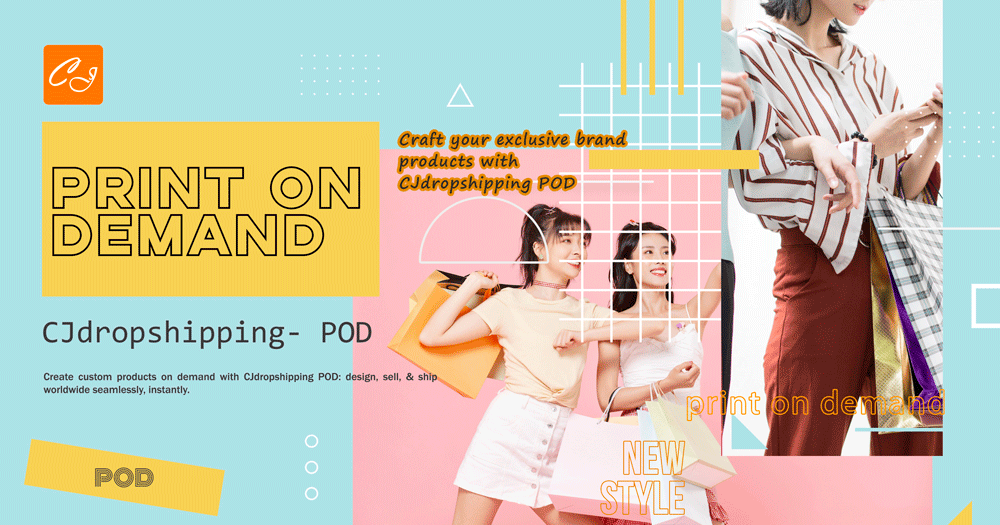
Should you stick with traditional dropshipping or venture into print-on-demand (POD)? Both business models allow you to run a Shopify store without holding inventory, but they work differently and each has its advantages. Let’s compare dropshipping vs. print-on-demand across a few key points:
Product Offering: Dropshipping gives you a huge range of products to sell – essentially anything a supplier carries, from electronics to clothing to home goods. You’re selling pre-made products from manufacturers or wholesalers. Print-on-demand, on the other hand, typically revolves around customizable products like t-shirts, hoodies, mugs, phone cases, wall art, etc., where your design is printed on a blank product when an order comes in. This means POD is fantastic if you have a knack for design or a concept for a brand, because you can create unique products with your art or slogans. In POD, your catalog might be smaller (limited to items that can be printed or embroidered), but highly unique since you control the design. With dropshipping, uniqueness comes from sourcing interesting items, but ultimately others could sell the exact same product. In short: dropshipping = someone else’s products, POD = your custom designs on generic bases.
Customization & Branding: Print-on-demand shines in branding opportunities. You can build an entire brand around your designs or niche (say a cat-themed apparel line with funny cat memes you created). You can usually add custom labels, pack-ins, or branded packaging with many POD providers, making the product truly yours. In dropshipping, unless you invest in private labeling through suppliers, you’re often selling unbranded goods – which can make branding a challenge since others sell similar items. As the Printify guide notes, in standard dropshipping you can’t customize products (unless using a private supplier) and must differentiate via marketing and brand story. So if brand loyalty and unique product identity are your goals, POD gives you more control.
Profit Margins: Both models can be profitable, but margins differ. With print-on-demand, your cost per item (printing + base product) is higher than bulk wholesale, but you set the retail price. POD experts recommend aiming for about a 40% profit margin on POD products. For instance, a custom t-shirt might cost you $12 to fulfill; you sell it for $20 – not a huge margin (8 dollars, 40%). Some sellers manage higher by pricing at premium (if brand is strong). Dropshipping physical products often has slimmer margins because you’re essentially acting as a retailer for commodity goods. Average dropshipping margins are about 15-20% – so, lower than typical POD. Of course, it varies by product: a trendy gadget might have 50% margin if sourced cheap, whereas electronics might be 5-10%. In general, expect POD to allow higher markup because you’re selling art/creativity (people pay for design originality), whereas dropshipped goods compete on price more. But note that POD requires marketing a brand which can be costly, and unsold designs don’t cost money (since they aren’t produced until sold) – a benefit. Meanwhile, dropshipping can benefit from finding super cheap sources and marking up moderately.
Inventory & Fulfillment: Both POD and dropshipping are order-on-demand models – no upfront inventory. With POD, every item is basically made to order (a shirt gets printed after a customer buys). This means production time is a factor; usually a few days to print then ship. With dropshipping, if your supplier has stock, they can usually ship in 1-3 days processing plus transit. However, many dropship suppliers are overseas which means longer shipping times to the customer (like 2-3 weeks) unless you use local suppliers or warehouses. Print-on-demand companies often have facilities in US/EU/etc, so shipping to those regions can be faster or similar to domestic dropship suppliers. Quality control: with POD, consistency can vary by print provider; you’ll want to order samples to ensure print quality is good. With dropshipping, you also should test-order products to ensure they meet quality expectations since you rely on suppliers.
Competition: Dropshipping popular items can be fiercely competitive – many stores might sell identical products, leading to price wars or heavy ad competition. POD can be less directly competitive if your designs are original – no one else has your exact design. However, the POD market is saturated in another way: thousands of people making t-shirts and mugs, so you need standout designs and marketing to be seen. You’re competing in creativity and niche targeting rather than exact product specs. For example, in POD if you target a very specific niche (say “funny shirts for pediatric nurses”), you might corner that sub-market with great designs. In dropshipping, if there’s a winning gadget, dozens of stores might pop up selling it. That said, a clever dropshipper finds unique items early or markets them in a new way to stand out.
Ease of Start: It’s relatively easy to start a basic dropshipping store – find products, import, write listings – you’re mainly curating products and writing good copy. For POD, the barrier is having or sourcing good designs. If you’re a designer or willing to hire freelancers, POD can be straightforward. If not, it might be tough to create designs that sell. POD also involves deciding on the niche/theme for designs up front (since a blank shirt is nothing without the graphic). One can combine models too – some dropshipping stores add a print-on-demand section for branded merch, as Kamil Sattar suggested using POD as a cross-sell (e.g., upselling a custom mousepad alongside a dropshipped office desk).
Example Scenario: Imagine an art-themed niche. POD route: you create an online store for witty graphic tees and mugs, design everything with a unique art style. When you make a sale, your POD partner prints and ships it from their facility (maybe in the same country as customer to minimize shipping time). You focus on creating new designs, marketing on social media (Instagram, Pinterest, etc. where art can go viral). Brand builds over time – maybe people recognize your artist name or style. Dropshipping route: you create a gadget store or a fashion accessories store. You find trending products, import them from AliExpress or use a US dropship supplier for accessories. You manage relationships with multiple suppliers for different items. When you sell one, you forward the order to the supplier, they ship to customer. You might have to deal with longer shipping times and ensure suppliers keep stock. You focus on product research and optimization of ads for each product.
Which is better? It depends on your strengths and goals:
-
If you’re creative or community-driven, POD can be rewarding – you effectively build a brand that could have loyal fans if your designs click. It can also yield higher margins per product and more control over branding. However, you’ll need to invest time in design and perhaps content creation to promote it (people won’t search for a design they don’t know exists – you must push it out).
-
If you’re more of a marketer/data-driven person who loves finding that next hot item and riding trends, traditional dropshipping might suit you better. You can be product-agnostic and just sell whatever sells, without the need to create from scratch. You can also populate a store quickly with lots of products to see what sticks.
From a customer experience perspective: POD products are usually easier to make look premium (nice packaging, your brand logo, etc.), whereas dropshipped items often come in supplier’s generic packaging unless you invest in custom packaging. Also, on average, a POD product shipping from a local print facility might reach a US customer faster than an AliExpress item from China (though you can also dropship from domestic suppliers or use fulfillment centers to mitigate that).
One could also do both: run a dropshipping store and incorporate some POD items. For instance, you have a pet products dropshipping store and you add a section for custom pet name mugs or T-shirts – leveraging your existing audience with some unique merch.
In essence, dropshipping vs POD is not an either-or choice; they are different methods. Dropshipping offers breadth of product options and often quick start, while print-on-demand offers depth of brand and design control. Many entrepreneurs eventually try both. For a beginner, dropshipping may generate cash flow quicker if you find a hit product, but POD can build a more defensible brand asset over time. Evaluate what excites you: curating cool items from suppliers or designing your own product line? Both can be profitable if done right. Just remember, success in either model still requires the fundamentals: good marketing, quality products, and understanding your target market’s desires.
Conclusion
Building a successful Shopify dropshipping business in 2025 means combining great products with smart strategy. We’ve explored over 50 of the best dropshipping products across industries – from home gadgets to fitness gear – and provided tips on why they sell and how to market them. These products can give you a head start, but remember that consistent research and adaptation are key. Use the tactics from “How to Find Winning Products” to keep your catalog fresh and leverage the traits of high-sellers discussed in “What Products Sell More” to evaluate new ideas.
Equally important is aligning your business model with your goals. Whether you concentrate on a niche you’re passionate about or ride the waves of viral trends, understand the trade-offs as discussed in “Niche vs Trends”. There’s no one-size-fits-all – you might even blend approaches as you find your footing. And if you’re eyeing print-on-demand, weigh its creative freedom and branding potential against the expansive world of dropshipping as we did in “Dropshipping vs POD”. You might discover that one model, or a hybrid of both, resonates with your style of entrepreneurship.
In the end, success in dropshipping comes from delivering value to your customers. That could be an innovative product that solves their problem, a curated store that understands their niche passion, or a custom-designed item that speaks to their identity. Stay customer-centric, keep optimizing (site speed, product descriptions, SEO, and ads), and don’t be afraid to carve out your own path – whether it’s through the 50 products we covered or the next trend you uncover on TikTok tomorrow.
Here’s to your dropshipping success in 2025 and beyond! By applying these insights and putting in the work, you’ll be well on your way to building a profitable, professional Shopify store. Good luck, and happy selling!

